#the themes of this one are heavily linked to his downfall
Explore tagged Tumblr posts
Text



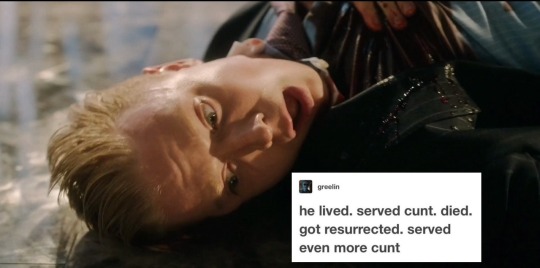



Spider + textposts part 1
#the themes of this one are heavily linked to his downfall#unintentional#slow horses#james spider webb#incorrect slow horses quotes#textposts#spider#also bcs of the DRM blocking on apple tv on my laptop i cant take screenshots--- therefor id like to thank everyone who took these/google#@saulbetter had really HQ ones so thank them
88 notes
·
View notes
Text
I reread a fic of mine and wanted to break down my symbolism (even if it’s just for me to remember haha!)-
I think dahlias was my fave fic I wrote but I just reread it for the first time in months and realized… I never said the book was Watership Down haha. I was silly and like “well I implied it!” But even in a way I barely caught… I know the earliest Japanese translations I could find had compasses on the covers and I described Ango’s eyes as “hazel” (there is a main character named Hazel in the book) despite it being lower light (hazel eyes appear more brown…). I can’t stand myself haha. So not that anyone really cares but the book was Watership Down, the one Ango heavily annotated and gave to him.
I think I initially wanted it to be strictly a sign of affection, like a “this is one of the sole remaining pieces of who I truly am/was.” But I think it could def be a bit of a hint as well, as a theme can be seen of pride can lead to a downfall. I did choose Watership Down specifically because of Fiver’s ability to see glimpses or prophecies of the future. So I did see it perhaps as a subconscious push from Ango to beg him to use his power and leave or at the very least survive.
As for the religious symbolism, although a bit cliche, I do think Oda plays a very symbolic Jesus-esc role in the story. I’ve rambled about this in the past and can go further in depth, but I’m a little tired. I will say at least when he tries to initiate something more intimate, though expressed he’d missed Ango in that sense, all he really cares about it how Ango feels. His own pleasure is put aside as all he wants is the confirmation he can do something for the other.
The kiss they share at the end, after the implied decision on Ango’s part that he has to go through with everything, even when he’s come to terms with the fact he does care about him, is in line with Judas and Jesus’s kiss. I think it was clear somewhat at least that the reason Ango visited was because he knew it was almost time and had been on edge over that so was making the final decision. He had made the “riddle” too difficult on purpose because a part of him was dreading seeing Oda again. But he showed up, and after being led on by temptation, he ultimately stuck to what he felt was right or at the very least knew he had to do. Another more cheeky toss for symbolism was the silver yen, silver coins were associated with Judas.
Although the called the first betrayal, I have always felt a bit of sympathy for Judas and never saw him as such a villain often described. Perhaps a bit silly but I wanted to portray that, that it hurts, that it aches, but what we feel is right or know we need to do, is often at the cost of others.
As for black dahlias, they are often a sign of betrayal. So I showed very briefly and vaguely at the end Oda was remembering an early hit in his career, killing someone in front of their flowers. I mildly implied it was either a more shameful hit/or they were shot in the back due to the blood falling on them. Ango is more delicate looking so I thought it was interesting to associate him with something traditionally beautiful, such as a flower but often turned into a symbol of death and despair. Hence a slightly negative feeling that comes with the term, metal bands have coined it and the murder case which I don’t feel comfortable mentioning by name.
Anyways… there’s some insight for anyone who cares n.n! I can break down some stuff in other fics I’ve written if anyone cares this was fun! And a shameless plug, or at the very least I think it’d be silly to ramble and not link it ^~^
#bsd fic#odango fan fiction#odango fic#oda bsd#fic writer#i just wanted to ramble :3 I hope this is ok
4 notes
·
View notes
Text
White Wolf, Black Wolf: Yuji and Geto
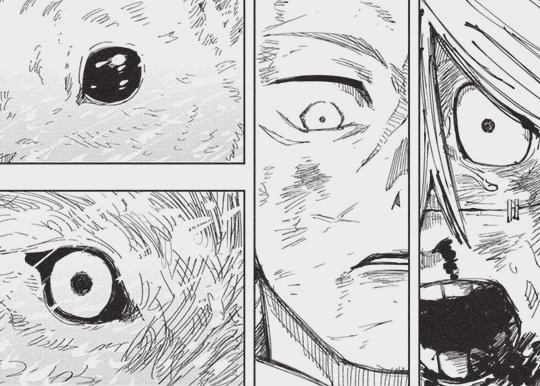
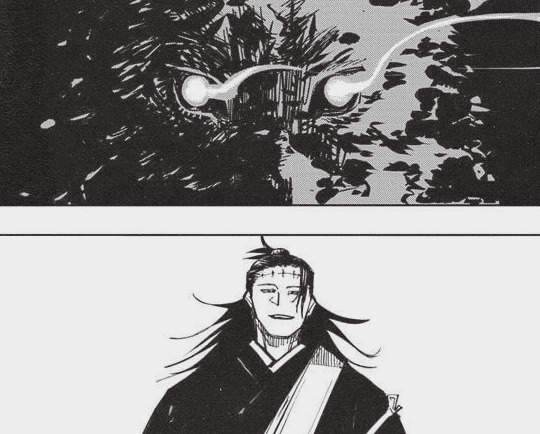
Dualism, is a common theme in Jujutsu Kaisen. There’s a difference between binary opposites and a completementary pair. Binary opposites supposes that two ideas are complete opposites of eachother, they are enemies and therefore cannot coexist. Death is the opposite of life. However, ideas like the concept of yin and yang suggest that these pairs are not opposites, or even enemies, they just exist alongside one another. The feminine yin contains a single dot of the masculine yang energy inside of it and vice versa.
This pattern repeats itself with both Geto and Yuji. Two characters who seem like they are complete opposites, enemies, hero and villain and yet have far more in common with one another than one might thing. Each of them represented by a wolf, Yuji the white wolf, and Geto the black.
Dualism - describing how seemingly opposite or contrary forces may actually be complementary, interconnected, and interdependent in the natural world, and how they may give rise to each other as they interrelate to one another.
1. You and the Worst Person You Know Have More in Common than You Thought
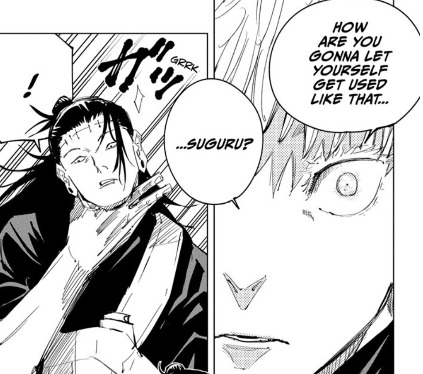
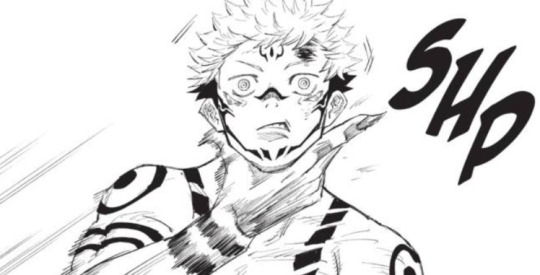
Both Yuji and Geto are sharing their body with another existence. Not only that but a sorcerer from the previous era. Sukuna started out as a sorcerer, and one from the golden age of sorcerers. We don’t know who is in Geto yet, but they’ve made it clear several times that they’re not a sorcerer from this era, mockingly referring to the sorcerers of this era as beneath them. The difference is, Yuji is the dominant personality and Geto is the subordinate one. They even fight for control of their body in the same way, by grabbing their neck.
Both Yuji and Geto have died, and then been improbably brought back to life one time already and had their body healed by the same person who seeks to steal their body. They also both died in front of their other half, their friend, Yuji dies heroically in front of Megumi sacrificing himself so Megumi doesn’t have to call Mahoraga, and Geto dies as a villain after his plan has failed executed by Gojo. Even the days they die are opposites, Geto dies in a clear sky and Yuji dies in the rain.
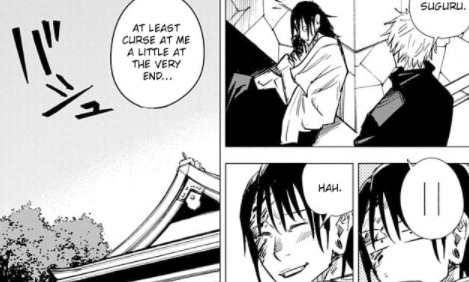
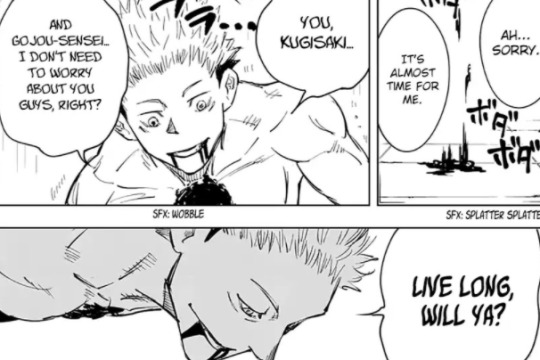
They both eat curses. Geto eats them physically in order to store them and use them later. Yuji consumes Sukuna’s fingers in order to grow stronger. Geto’s Jujutsu is themed around his stomach, Sukuna’s is cooking themed.
Yuji and Geto are both have savior / martyr imagery attached to them. They’re both people who have died, and come back from the dead at least once, and the jesus imagery with Geto is clear and explicitly referenced in hidden inventory.
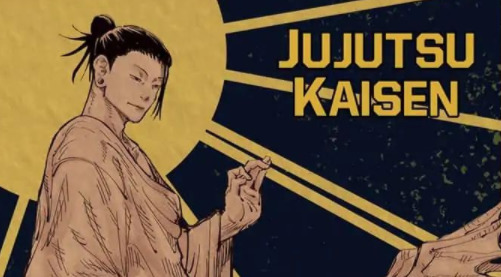
Yuji wants to be strong like Gojo, but it’s clear he follows Geto’s philosophy of wanting to save as many people as possible. What motivates him isn’t a clear and strong sense of individualism, but rather the idea that the strong are duty bound to help the weak. Even when Geto’s completely out of his mind he’s still guided by that principle, if he has the strength to do it, then he’s duty bound to try to change the world in the way he sees fit. The thing with Geto is his ideals are warped, but they’re still ideals, he has principles guiding him. These ideals also shockingly sound similiar to what Yuji says, and the burdens he wants to carry.


It’s something that doesn’t change about Geto from the start to the end of Hidden Invenotry, the strong are obligated to help the weak, it’s just Geto flipped. he sees the sorcerers as the weak and oppressed people, and the masses as the strong ones.

Geto and Yuji are both people heavily preoccupied with doing the right thing, whereas Gojo and Megumi kind of don’t care (Gojo) / have already accepted the fact (Megumi) that they’re not really saving people with their actions. Geto and Yuji are reckless saviors, they kind of just want to save everybody they see suffering in front of them immediately without thinking through the consequences of their actions. It’s never been seriously analyzed why Yuji feels so deadset on saving others, but from early on he seems to like the idea that it’s a burden that only he can take on himself. It’s something he must duty. The same way that Geto binds himself by the idea of duty.

Geto and Yuji are just people who will take the whole world on their shoulders, and this isn’t just a parallel I’m making it’s one directly made by the narrative. When worrying about Yuji’s future, Yaga thinks directly of Geto someone who became overwhelmed by everything on is shoulders.
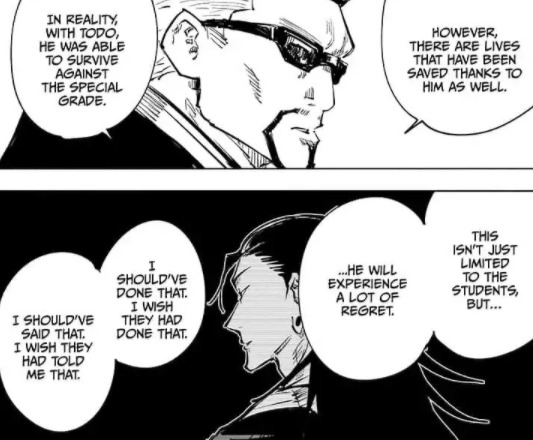
Geto wasn’t able to carry on as he once did, because he couldn’t carry the regret with him. That’s the parallel that the story is making with Yuji, that’s the danger Yuji is in.
2. Worst Person You Know Makes a Good Point
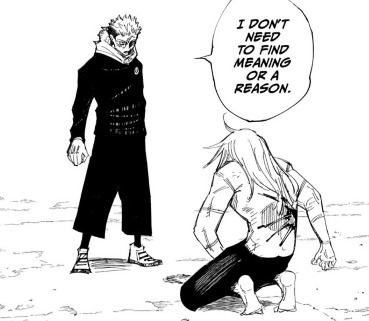
Chapter 132 there’s a definite change in Yuji’s demeanor. While we haven’t seen the full results of his change yet, not only has he been phsically scarred on his face, but it’s clear the deaths of Nanami, the people killed by Sukuna, all have served to harden him. Nanami wanted Yuji to remain a child a little bit longer, but Yuji has now become a jujutsu sorcerer. However, the words he declares to Mahito have two clear connections to Geto. One, it’s what Geto said to Gojo to stop him from slaughtering the star plasma vessel cult in the moment.
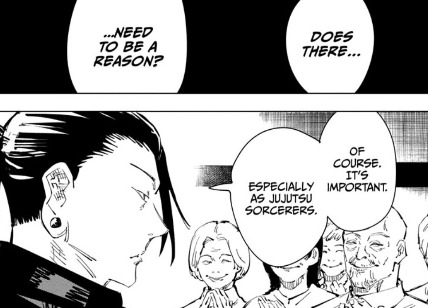
Gojo has feelings of course, but he’s not moved by them the same way that Geto and Yuji are. Gojo was in need of a tether in that moment and Geto’s words became his tether. Remember Gojo became so powerful as the strongest one he felt like he was capable of anything without feeling it, even slaughtering people on mass, but in that moment Geto became the link that held him back and reminded him he was human.
What’s ironic is that Gojo was moved by Geto’s words and held himself back, whereas Geto wasn’t. It was Gojo who stuck to those words a year after the fact. He was the strongest, but he doesn’t ever act unless he carefully considers it. He doesn’t just throw power around or slaughter people the way that Geto does.


What Yuji is vowing to do right now, following his duty as a jujutsu sorcerer without even thinking about it, is exactly what drove Geto apeshit bananas (you see because he loves monkeys so much. It’s a, ‘yknow, it’s one of them jokes).
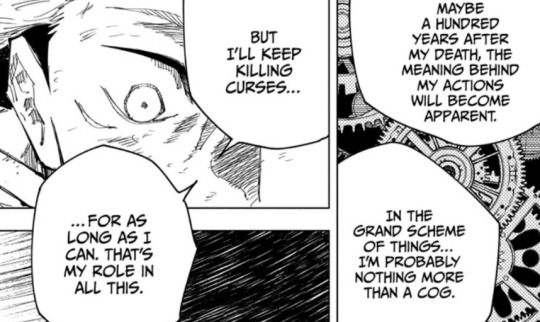
Yuji thinks he can just keep going on without thinking and being nothing more than a cog, but it’s exactly that kind of mechanical subservience that completely wore out Geto. Simply going through the motions without questioning it is given to us as the exact reason for Geto’s downfall, it’s one of the most chilling sequences in the manga.
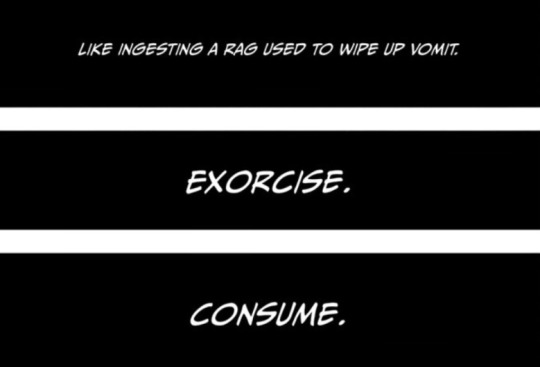
People aren’t machines, and they aren’t gears, they break down when they try to conform that way. So while it’s understandable Yuji would want to push away all his thoughts in the moment, it’s also not healthy.
The reason Geto became the way he is, is because he realized the laws he was obeying weren’t as fair as he thought they were. He thought it was his duty, and obligation to help the masses, until he looked at his actions with closer scrutiny and realized that wasn’t really what motivated him. Geto thought what he was doing was good, that he would save people, but then Riko’s death was a reality check to him that no one was getting saved by the current system. Yuji seems to have done the opposite of Geto so far. Perhaps I won’t save people. Perhaps I’m just a cog in the machine and my actions truly don’t matter as long as I can keep fighting with my comrades as a jujutsu sorcerer. However, that’s probably not going to work for him.
Yuji’s current comfort in his moment of crisis is that he’s fighting together with all of his comrades, that he carries the wishes of people like Nanami and that’s why he has to keep going, but Yuji also might not have comrades in the jujutsu world after this. We already see people like Kusakabe beginning to turn against him because of Sukuna’s rampage in Shibuya.

So my intention in all of this is to say it’s not black and white. (Because, get it?? black wolf, white wolf??? Okay, I’m sorry I’ll shut up). Geto wasn’t an entirely bad person, there was good in him too. There was still good in him. This is what Getwo says when he’s beating on Yuji, that if Geto had used his forces more like disposable pawns instead of family telling them to fall back and making sure they all lived he would have won.
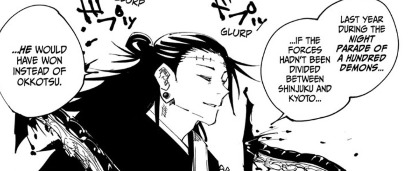
The worst person you know, was still a human being who loved his family with all of is heart. Ideas like this challenge Yuji’s simplified reasons for fighting, and his naive view of the world.
At the end of the day Yuji and Geto have lots of similarities. They’re opposite colors, Geto black, Yuji white, but they are both still wolves. They’re both moved by deep emotions they feel at the pit of their stomachs. They’re both people who sympathize with others and want to save them, and at the same time get angry and want to kill their enemies. None of this is bad about Yuji in fact it’s what makes him unique among shonen protagonist, he’s not a wholly good person, but just as flawed as anyone else in the story. Nobara’s crazy, Megumi’s crazy, Gojo’s crazy, and then there’s Yuji who should have been the normal one who grew up with a normal life and who is just as crazy as all the rest.
If anything the parallels between Yuji and Geto show that Yuji is someone who has the chance to grow stronger than Geto by learning from Geto’s fault. Geto tried to carry too much, until the burden of saving the world broke him and he decided he could only save a few people the rest were just monkeys. It’s up to Yuji now to figure out what saving people means, and how he can help others without getting destroyed by the sense of responsibility or just killing himself and dying before he’s helped a single person. However, for Yuji to learn to be better he actually has to think about these things.
That’s also the second parallel to the “I don’t need to think about it’ Scene. (Besides, Sukuna who also declares that he’ll kill for no reason.) In the original Geto fight in the prequel manga Yuta declares this. He doesn’t know whether Geto is right or not, he doesn’t know anything about the world of Jujutsu he just wants to protect his friends.


Geto calls him egotistical. In the sense that just like a child, he’s only really thinking about himself and his own emotions. Of course Yuta thinks that way because he is a child, a traumatized teenager at that. However, one important detail about this fight is defeating Geto did not cause him to go away. Killing him didn’t actually fix the problem. Geto just came back a year later with somebody else in his body.
I think this is all leading up to a point for Yuji where he gives some serious self examination as a protagonist. It’s not enough for Yuji to just defeat his enemies. We even see that when after is triumphant moment with Mahito, Geto just wipes the floor with him.
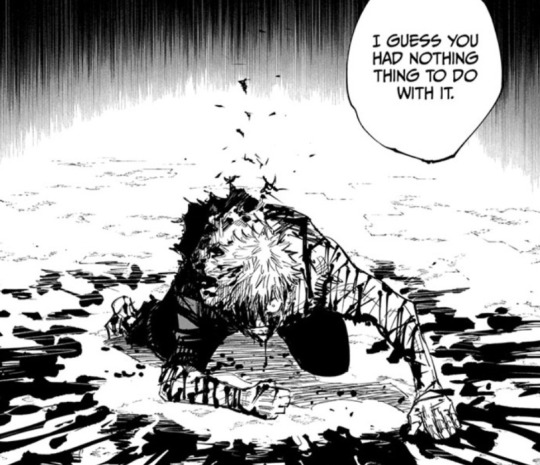
Jujutsu Kaisen presents a very complex world, that’s not just black and white, not just winning and losing. The next big step in Yuji’s character development is probably going to be realizing this. That he needs to seriously think about his reason. That he needs to think about what he wants to do in the future. It’s not enough for him to sacrifice his life to save someone else, he’s not a hero, or some martryr to a cause. I think the most important thing Yuji has to learn at the end of all of this is to actually live, and find out why he’s alive instead of resigning himself to the fact that he’ll get executed one day. It’s only then Yuji will be able to reach his full potential as both a jujutsu sorcerer and a person.
He’s just a kid you know? The theme of the manga is kids should get to be kids. Yuji should get to grow up just like everybody else, instead of dying before he’s even old because he ate Sukuna’s finger to help someone else.
#itadori yuji#yuji itadori#geto suguru#suguru geto#jjk meta#jujutsu kaisen meta#jujutsu kaisen theory#jujutsu kaisen analysis#jujutsu kaisen
665 notes
·
View notes
Text
Legion Rewatch Notes,
Chapter 4:
Frizzytop
I theorized in episode 2 that David could see through the 4th wall, or at least into a different universe. At the start of this episode Oliver outright breaks the 4th wall. Perhaps powerful reality benders just have that capability. If David knows, and Oliver knows, then Farouk definitely knows.
“A great philosopher once wrote, ‘In times of peace, the war like man attacks himself.’ This is the route of all our problems.”
“We are the route of all our problems. Our confusion, our anger, our fear of things we don’t understand.”
If we carry those 2 quotes throughout the rest of the show, then no doubt the tragedies that happen later on are caused by a collective misunderstanding of each other. And a collective lashing out at that misunderstanding of each other.
“Violence, in other words, is ignorance.”
The most central theme of the show is empathy vs fear. I s’pose whenever there’s a conflict in the show we’re supposed to be asking whether the characters should answer with empathy or fear. Certain characters lives have revolved heavily around fear. And that informs their decision making quite a bit. This will all come up again at multiple points throughout the show.
Syd... probably can’t break the 4th wall. So maybe it’s most logical to interpret this as her inner monologue. Very Jessica Jones esque.
The same voice lines from when Syd was searching for David in episode 1 are played. I guess there go to whenever Davids lost (whether in the world or in his mind) is to transmit Syds voice calling his name in hopes he’ll hear it and come back.
Kerry can pick locks.
The concept of “bad mutants” is well established amongst the veteran summerland crew. Ptonomy’s caution about David is probably because he feels he has a selfish vibe, and that’s a well known red flag of “bad mutants.”
It should also be noted he’s partly afraid of him because he has so much trouble understanding him. His powers, which when used affectively are essentially the ability to understand where someone’s coming from, keep getting overrided by Davids.
It’s now to the point where Ptonomy is doubting his own ability to tell what’s real and what’s not real. He was pretty confident he’d always know somehow in episode 2. Now, not so much.
Ptonomy very early on is open to the idea that David both has powers and psychological issues. “He’s unstable. You try hearing voices for 10-15 years, self medicate with hard drugs and then get dumped in a looney bin.”
Ptonomy also determines that because of his instability combined with the fact he has powers, David is a bomb waiting to go off.
I suppose if we’re trying to figure out their logic with the whole “the combination of being mentally ill and having powers makes him dangerous”, and considering that their right now going over an incident where David robbed his therapist for drug money and then bashed the doctors head in when he came back, the direct concern is that David makes bad decisions and/or selfish decisions (at least), and if he were to make a bad decision regarding his powers a lot of innocent people could get very badly hurt. Or killed. Along with the worry that the voices in his head don’t exactly give him the most angelic of advice at times, and because of his powers he’s very capable of fulfilling their wills, so to speak.
Based on Olivers speech at the beginning of the episode though, it might be safe to say the overall message is instead of acting on fear they should act on empathy and help David overcome his problems instead of vilifying him for his mental illness.
Syd suggest Davids hiding his real memories behind a fake ones and Ptonomy says she going through a lot of effort just to convince herself Davids a good guy. I never really got what he meant, but I guess what he meant is that Syd’s trying to find a justifiable reason for why David would attack Dr Poole like he did when the obvious answer is just “He’s got violent tendencies.” I always just thought she was genuinely hypothesizing, ya know, trying to solve the case. Maybe she was and Ptonomy’s just mean.
“I was looking for the man I loved. Or did I just love the idea of him? The face he showed me?” Doubt springs up early. Why can none of the characters reconcile that a person can have both good and evil in them at the same time? That’s... all people, in fact.
When Kissinger ask if Amy knew David had powers Amy says, “I think so.” Amy potentially acted on fear as well, in regards to her and Davids childhood that is.
Kerry mostly only thinks of herself in relation to Cary.
Cary misses Kerry when she’s gone. Even besides the roles they fill for each other, they generally enjoy each others company. They’re quite literally as close as 2 people can be. Each one living for the sake of the other.
Davids once again surrounded by a crowd of people all yelling in his face. After they disappear though he recovers pretty fast. I guess he’s used to it.
Clockworks Podcast pointed out that the music Davids wincing at is sax heavy Jazz, which is (abstractly) the sound The Devil With Yellow Eyes makes whenever he appears. If my theory about David seeing through the 4th wall is correct, then maybe he’s actually hearing that sound whenever TDWYE is around. Alternatively, Farouk blast that in his head everytime to mess with him.
“Sorry... I forgot about your um... I had a similar- proclivity? Malady? I forget the word- what’s the word? I’ve been here a long time.”
If the previous paragraphs are right, Oliver’s probably implying he was also affected by a mental parasite at some point. It might’ve even been what stranded him in the astral plane.
From Davids perspective he skipped over the entire second half of Chapter 3.
Oliver is essentially explaining the plot of the show to David and the audience before it’s even been unfurled.
“You have an unquiet mind, so you war with yourself, like a dog trying to chew off its own tail.”
David’s still in a very pessimistic guilt ridden place at this point in the story. That’s probably the internal war Oliver’s talking about.
... why can’t Oliver leave the astral plane again? If he did have his own mental parasite, it seems long gone by now. If he just can’t find his way back, then how does he do it in Chapter 7?
Syd calls non-mutants “normals.”
“We were the ghost in a haunted house.” ~Syd, Chapter 4
“You think ghost like living in a haunted house?” ~Syd, Chapter 12
Why does Syd keep hallucinating The Angriest Boy? Or is that just visual metaphor?
Ptonomy’s a very, “Get the job done and look classy while doing it” sorta guy.
“To fight and conquer in all our battles is not supreme excellence; supreme excellence consists in breaking the enemy's resistance without fighting.” ~Sun Tzu, Ptonomy
Is the above quote perhaps relevant to the shows message during other conflicts throughout the series? Could it be subtly implying all the characters should always look for non-violent ways to defeat their enemies? I.e. not just a classy line from Ptonomy, but a statement of themes within the show.
The food David, Philly, and Dr Poole are having in Philly’s memories is cherry pie.
In Philly’s memory David says, “I don’t keep a lot of stuff.” And Philly comments that there’s no evidence David had a past. At least among the things David owns at that point. I know Farouk edited a lot of Davids memories, but why did David himself get rid of so much physical stuff? Syd said the reason he broke into Dr Pooles that day was to destroy their taped conversations. What’s compelling him to erase himself from existence? Is it as simple as “Farouk”? It seems like on a deeper level David doesn’t want anyone to know too much about him. Everyone’s only allowed to know what he tells them. His way of feeling in control I guess.
Philly did the classic “I can fix him” when she started dating David.
Philly implies David going off his medication and keeping bad company is what caused the downfall of their relationship. And subsequently his life, probably.
Despite everything, Philly still feels sympathetic towards David.
“Whoever altered Davids memory-“ Ptonomy very early on humors the idea that Davids being acted on by a 3rd party.
The longer Kerry is away from Cary, the more antsy she is for a fight. She’s not supposed to have to sit through all this “boring stuff.”
Ptonomy left after he got the info on Pooles location from Philly. He probably wanted to get the rest of the information from the source. Ironically, they probably woulda gotten closer to the real answer if he’d just looked a bit longer.
Sys proudly says “Yes” when “Dr Poole” ask if she’s in love with David.
It never really comes up again, but Kerry and Cary are physically linked. Maybe even psychologically. When one of them gets hurt, or even exerts their body a lot, the other can feel it, even if their own body doesn’t take on the actual damage. This is still true even if they’re miles apart.
Syds definitely portrayed as the hero at the end of this scene.
“All those years of practice-“ A part of David always knew he had powers. I wonder, did he practice a little in secret? Or is he saying he was at Summerland for years? That doesn’t really add up. But then... what does he mean by years?
Lenny encourages David to get angry so that his powers will strengthen enough for them to overpower the astral plane. Sort of... cheating his way out. David will later achieve more feats of strength through honing his emotions. Like many heroes, his level of power is intrinsically linked to his emotional state.
Very directly here, Davids violence is caused by ignorance. He doesn’t know Syd switched bodies with Walter and is trying to escape.
3 notes
·
View notes
Text
ESSAY: Kali - Polysemantic Goddess
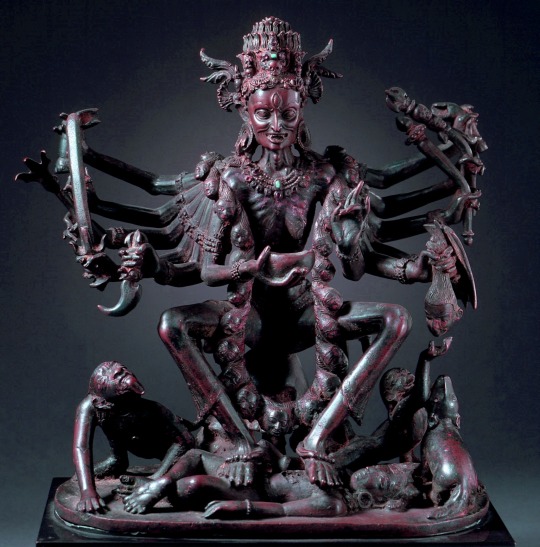
...Kali is, at her core, the embodiment of opposites. Through her, Hinduism has syncretized a variety of extremes: destruction and creation, death and rebirth, mother-love and sovereign sexuality, primordial violence and self-sacrificial wisdom.
Among the multifaceted pantheon of Hindu deities, the goddess Kali occupies perhaps the most fascinating yet frustratingly misunderstood position. Her iconography – filtered through the lens of parochial presuppositions – often distorts her persona into that of an ogress: bloodthirsty and warlike, with a penchant for destruction. However, this prescribed identity disregards the rich nuances of Kali's origins, reducing her instead to a chimera that arguably embodies the submerged fears of the archetypal, independent feminine. Too often, in text and media, she has been either devalued or demonized, consigned to the same spectrum of mythological would-be villainesses as Lilith, Hecate or Morrigan. New Age depictions of Kali are equally suspect for flattening her into a mere tool for social discourse. Neo-paganists and Western Kali enthusiasts have been accused of appropriating the goddess as a one-dimensional figurehead for Mother Earth, or as a self-serving expression of radical female sexuality, without taking into account her deeper symbolism within Hindu philosophy.
Modern cross-fertilization between the two cultures, thankfully, has allowed academics to defuse these seemingly irreconcilable caricatures. Today, a wealth of literature is devoted to understanding Kali's complex character and role. By navigating the maze between misconception and truth, what emerges is the realization that Kali is, at her core, the embodiment of opposites. Through her, Hinduism has syncretized a variety of extremes: destruction and creation, death and rebirth, mother-love and sovereign sexuality, primordial violence and self-sacrificial wisdom. Kali's incarnations, whether tranquil (saumya) or fearsome (rudra) are simply manifestations of omnipotent cosmic energy (sakti) which is the fuel within and behind every phenomenon of the manifested world. Kali, in short, is the fulcrum around which the cosmos revolves, and she wields her power in both transformative and terrifying ways.
Perhaps most remarkable is that, in Hinduism, Kali is affectionately referred to as Maa, or Mother. This title of respect, with its intimate subtext, is important not because her devotees attempt to distinguish between the maternal Kali and the sanguinary Kali, but because in Hinduism, destruction and creation are regarded as complementary, rather than diametrical, facets of a single continuum (Kinsley 15). With each rebirth, human beings are free of the negative traits conducive to social and personal downfall: cruelty, greed, egotism, self-interest etc. This blank slate goes hand-in-hand with the opportunity to do good karma. Each birth is a new beginning, a fresh start to awaken one's potential for self-transformation. Death, therefore, is not a stillborn story, but one that begins, instead of ending, with the power to sidestep adharma and tread fully across the true dharma path. To accomplish this, Kali is instrumental. She is the Divine Mother who frees her children from the limitations of the physical realm – in this case the cyclical tedium of samsara. Infinitely patient and benevolent, she nurtures the souls (atman) of human beings until they have perfected their understanding of the Ultimate Reality (Brahman) and achieved liberation (moksha). Her color, the pure black of nothingness, can be viewed as the primordial womb within which the enlightened souls merge (Frawley 133).
Of course, to fully appreciate Kali's extraordinary complexity, it is necessary to delve into her etymology and history. In his book, Devī-māhātmya: The Crystallization of the Goddess Tradition, Thomas B. Coburn remarks that while Kali is simply a feminine play on the adjective Kaalam, or "darkness," the latter can also be linked to the derivative noun Kaala, or time. Kali, then, is meant to symbolize "that which brings all things to an end, the destroyer" (108). Kali's mythology and the beginnings of her worship are difficult to trace. However, the earliest known mention of Kali is observed in the Mundaka Upanishad, where she is the name of one of the seven terrible black tongues of the fire-god, Agni. In the Mahabharata, she makes a token appearance as one of the "mothers" who become companions of Karttikeya as he boldly ventures forth to slay the demon Taraka. But it is not until the Markandeya Purana, within the chapter Devi Mahatmya ("Glorification of the Goddess") that she makes her awe-inspiring debut. Here, Kali is depicted as both the purest manifestation of divine wrath, but also as the delivering heroine who is summoned to salvage a disaster that threatens to tear apart the fabric of the cosmos itself. Her mission is to destroy the demon-lord Rakhtabeeja (blood-seed) who possesses the power to generate clones of himself with every drop of his blood spilled to the ground. In the book, Kali: The Feminine Force, Ajit Mookerjee describes how Kali:
...manifested herself for the annihilation of demonic male power in order to restore peace and equilibrium. For a long time brutal 'asuric' (demonic) forces had been dominating and oppressing the world. Even the powerful gods were helpless and suffered defeat at their hands. They fled pell-mell in utter humiliation, a state hardly fit for the divine. Finally they prayed in desperation to the Daughter of the Himalayas to save gods and men alike. The gods sent forth their energies as streams of fire, and from these energies emerged the Great Goddess Durga. In the great battle to destroy the most arrogant and truculent man-beasts, the goddess Kali sprang forth from the brow of Durga to join in the fierce fighting. As the 'forceful' aspect of Durga, Kali has been dubbed 'horrific' or 'terrible' in masculine-biased commentaries, without understanding of the episode's inner meaning (21-55).
It is certainly true that Kali contradicts the ideological construct of the feminine as subordinate to the masculine. However, while Hindu philosophy binarizes its deities into symbols of male and female energy, it should be noted that there is an implicit androgyny within each depiction. Collectively, the Hindu pantheon represent the various spatial aspects of Brahman. Each god is an alternate component to a singular theistic unity. Gender is not always integral to this classification, although one can argue that within the social framework of Hinduism, which is heavily male-dominated, it carries significant weight. But that is, perhaps, what makes Kali all the more fascinating. Here is a goddess whose depictions are unabashedly female, yet who embodies the integral Hindu tenets of power and nature (sakti/prakriti), while simultaneously defying orthodox constraints of traditional Indian womanhood. In the book, Hindu Goddesses: Beliefs and Practices, Lynn Foulston and Stuart Abbott remark that, by transgressing the limitations of conventional Hindu womanhood, Kali represents the "transcendence of social and worldly values and the freedom this brings... As one of the Mahavidyas (i.e. one of the ten aspects of the Goddess Shakti), Kali can be understood as a liminal symbol, both occupying and traversing the very boundaries of social purity and order, danger and pollution" (118).
The diverse Puranic oeuvre only heightens Kali's uniqueness. Mother, lover, warrior, martyr – her story runs the whole gamut of human experiences. In popular folklore, for example, Kali slays the demonic Daruka and consumes his blood. However, she becomes dangerously intoxicated by the evil flowing through her veins, driven into a rampaging bloodlust. Like an embodied natural disaster, she sweeps across the earth, spreading catastrophe in her wake. Implicit in this tale is the theme of self-sacrifice. While the ferocious Kali is born to vanquish evil, it is clearly at the cost of herself (157).
Other versions present a more empowering outlook. In the book, Questions on Hinduism, John Renard recounts how, in a desperate attempt to cool Kali's wrath, her consort, Shiva, throws himself beneath her feet. This act establishes him as her more passive counterpart, playing on the pun Shava (corpse). More to the point, Kali's story clearly "identifies the female as the energy, the divine spark at the heart of reality, which confers on creation the power of transcendence" (124). Indeed, in traditional as well as contemporary artwork, Kali is often depicted as dancing upon Shiva's supine form. In these portrayals, titled the Dakshinkali, she embodies the unstoppable dance of Nature, while her mate, Shiva, becomes the manifestation of Consciousness. Rather than an active force, Consciousness plays a silent witness to the dynamism of Nature. Shiva, sprawled pale and corpselike beneath Kali's foot, illustrates how all that Consciousness perceives is the force of Nature (Pattanaik 53-67).
In other versions, Shiva does not throw himself beneath Kali's feet, but transforms into a bawling baby. When Kali hears the cries, her fury is subsumed beneath a flood of maternal instinct. Gathering the baby to her breast, she nurses him; her violent potential is thus sublimated into motherly largesse. While this retelling can be criticized as a patriarchal misappropriation – a blatant attempt to tame seemingly-destructive female independence through motherhood – it can also enjoy a kaleidoscope of interpretations. In contemporary Western feminism, it is perhaps not always fashionable to exalt motherhood, which so often conflicts with female self-expression and autonomy. However, the fact that Kali, whose persona is so fearsome, is woken emotionally by a child, and is able to discover opposite yet apposite aspects of her own fiercely protective nature, holds a life-affirming sweetness (Mohanty 55-70).
Other narratives completely dispel the notion that even the all-powerful Kali is inherently submissive to the male form of the divine. In the Tantric version of the Kali's battle, Shiva assumes the guise of a beautiful man and lays himself across Kali's path. Here, as in other adaptations, Kali ceases her rampage after stumbling across Shiva's chest. However, in this case, it is because she is consumed with lust. Flouting the conventions of decency, she straddles Shiva out in the open and begins to make love to him. For many, this combustible blend of violence and sexuality is an empowering motif with a potentially subversive edge. For others, however, it comes as no great shock that Kali, as the purest and most dynamic representation of sakti, is equally unapologetic of her desires (75).
Indeed, Tantric depictions of Kali engaged in coitus with Shiva, which shocked early British settlers as prurient, in fact held intensely ritualistic and symbolic underpinnings. According to Tantric doctrines, the human body symbolizes the microcosm of the universe. As such, Kali's union with Shiva is neither sinful nor shameful, but integral to the process of creation. In the book, Encountering Kali: in the Margins, at the Center, in the West, Rachel Fell McDermott et al. analyze this particular myth, faithfully recreated in ancient and contemporary artwork: "Siva is the inert soul, purusa, whereas Kali is the active, creative prakriti.... Tantra emphasizes the 'erotic' (that is, the simultaneously sexual and religious) symbolism of the image. In defiance of conventional sexual mores, Kali engages intercourse with Siva in the 'reverse position' ....since siva depends on sakti for the ability to orchestrate creation, preservation, destruction" (53-55).
Equating this unadulterated female power with the negative – a proclivity often seen in patriarchal interpretations – would be fallacious here. So too would be the tendency to pedestalize the divine, to fit female deities into tidy, distinct boxes of "maidenly" or "motherly." Kali's very mythology allows these generalizations more breathing space. Her destroyer/creator/mother/warrior/temptress/martyr mystique encompasses every facet of existence, from the beautiful to the horrifying. At the most fundamental level, her mythos serves to provoke a reaction – primeval, visceral – from observers and devotees alike. Rather than reducing her extremes to intellectual abstractions, her stories allow her to feel close and human. One might even argue that Kali's presence extends beyond liturgy and theology. Hers is a tactile and emotional experience; she exists equally in the frailties of human life and in the inevitability of death, in the fierce desire to nurture but also to defend, and in the human capacity for infinite, unceasing transformation.
Iconography, of course, serves to highlight her polysemantic and multifunctional role. Every aspect of her appearance carries a potent philosophical epithet. She is often depicted as a ferocious four-armed woman with either pitch black or dark blue skin, a mane of matted hair, three blazing-red eyes, sharp white teeth and a lolling red tongue. She is typically nude, festooned only in a necklace of skulls and a girdle of severed limbs. In two of her four arms, she wields a scythe (kharag) and a severed male head; the remaining two arms are positioned in hasta mudras that communicate the seemingly-ironic message 'Do not fear.' Despite this frightening visage, she is sacrosanct for well-grounded reasons. Her dark skin is tied to earth and space; to the fertile soil of the physical realm and the infinite darkness of the primordial cosmos. Much like black represents the all-encompassing quality of darkness, so too is Kali's darkness the signifier of her benevolent and accepting nature (Harding 38-52).
Equally powerful is the message behind Kali's nudity. She is described as garbed in space, or sky-clad, and this "absence of clothes denotes the absence of illusion" (Mascetti 47). In that sense, she is Nature at its most sublime, transcending the boundaries of name and form. As the Universal Truth, she has conquered the illusory trappings of maya. Through her, devotees can transform blind consciousness into perception, just as a wash of intense light illuminates dark corners, dissipating the shadows of ignorance. Her unbound hair, too, is charged with symbolic and cosmological significance. In the book, Tantric Visions of the Divine Feminine: The Ten Mahāvidyās, David R. Kinsley suggests that Kali's disheveled mane of hair, such a jarring contrast to the way traditional Hindu women plait their hair in deference to social order, is indicative of Kali's unbridled independence. "Kali is free from convention, wild and uncontrolled in nature, and not bound to and limited by a male consort." In the same vein, Kali's loose curtain of hair is interpreted as the swathe of Space-Time, with its tangled mass suggesting the dissolution of cosmic balance. "Her hair has come apart and flies about every which way... all has returned to chaos. The 'braidedness' of social and cosmic order comes to an end in Kali's wild, unbound, flowing hair" (83-85).
Similar dualistic interpretations are found concerning Kali's tongue – blood-smeared and protruding. According to Puranic lore, Kali's lolling tongue allows her to slurp up the blood of Rakhtabeeja, before it can drip to the ground and spawn clones. In other narratives, Kali's outstretched tongue takes on broader, more psychological connotations. In The Book of Kali, Seema Mohanty states that, "With the outstretched tongue, Kali teases and mocks her devotees. She sees through their social façade and knows the dark desires they try so hard to deny or suppress. She provokes them to delve into their subconscious and confront all those memories and thoughts that they shy away from" (10).
For the colonial West, of course, this aspect of Kali's iconography seemed to fuse sexuality with brutality, social perversion with graphic violence. In the book, Encountering Kali: in the Margins, at the Center, in the West, McDermott et al. remark that Kali's tongue, filtered through the Western lens, became a blatantly phallic symbol, her persona little more than a terrifying figurehead of idolatrous depravity. Indeed, McDermott argues that for the colonial imagination, Kali was the embodiment of India itself, "imbued with debauchery, violence and death. Objectified under the 'colonial gaze'... Kali has always been an ambivalent source of mixed horror and fascination, of simultaneous revulsion and lurid attraction" (170-178). Unfortunately, such depictions, rooted in Eurocentric ambivalence, fail to appreciate Kali's full complexity. As a goddess, Kali explores and symbolizes all the uses and expressions of submerged human desire. It should be noted that in this instance, desire does not refer simply to biological imperatives with their natural rhythms of arousal and satiation. Nor is it linked purely to the erotic desire that is cloaked in visual and textual symbolism. This is desire at the cosmic, primordial level, beyond limits and civility. Taken in that sense, Kali's tongue "denotes the act of tasting or enjoying what society regards as forbidden, foul, or polluted... an indiscriminate enjoyment of all the world's 'flavors.' What we experience as ... polluted ... is grounded in limited human (or cultural) consciousness ... Kali invites her devotees to taste the world in its most disgusting and forbidden manifestations in order to detect its underlying unity or sacrality, which is the Great Goddess herself" (Kinsey 81-83).
Kali's ornaments and weaponry, too, carry a reservoir of allegorical and mystic nuance. Her garland of severed heads represent the fifty letters of the Sanskrit alphabet. These seedlings (beej) of sound – particularly the eternal syllable, Om – are the source of all creation. Adorned in the essence of reality, Kali is therefore the repository of eternal knowledge. She "decapitates words so that the seeker of truth is liberated from the limitations imposed by language" (Mohanty 13). Similarly, her girdle of severed limbs represents karmic annihilation. Each arm symbolizes the binding effect of deeds – karma – that Kali effortlessly chops down. Thus, she is instrumental in liberating her devotees from the cruel cyclicity of samsara, allowing them to achieve the ultimate spiritual realization (14).
Completing her otherworldly allure, the conjunction of femininity, monstrosity and strength, are Kali's four arms. According Bob Kindler's book, Twenty-Four Aspects of Mother Kali, her arms symbolize the cosmic circle of creation and destruction. The upper and lower right hands confer gracious and protective boons, the hands positioned in the Abhaya and Varada mudra respectively. The former is "a mystic gesture indicating the Divine Mother's serious warning to negative forces that attempt to harm Her precious spiritual children." The latter, meanwhile, signifies "gifts to those who approach Her for refuge" (22). Her left arms, brandishing the bloodied scythe and the severed head, symbolize Kali's power to eradicate ignorance. The head represents false consciousness, or the ego; the scythe is the weapon of knowledge. Thus, by slicing through the obstacles of ignorance, Kali frees her devotees from temporal bindings. Finally, her three eyes speak of her omniscience: they represent the sun, moon, and fire, which she uses as mediums to unlock the three facets of time – past, present and future (Kinsley 86-90). In ancient Greece, the ouroboros – a primeval serpent devouring its own tail – served to symbolize the coincidence of opposites, the infinite oscillation between destruction and creation, death and rebirth. In the same manner, Kali perfectly embodies the circular transience of being, the pivot upon which cosmic equilibrium rests.
Both legends and iconography reiterate her gift for transcending the broad spectrum of dichotomies because it is relevant. At her core, Kali's myth defies humanity's efforts to classify and control the unknown as a way of asserting its standing as a rational, privileged species. She corrects us of the dangerous misconception that human beings are a dominant outside force, rather than fragile stitches within the cosmic fabric itself. By understanding Kali, it is therefore possible to spark a genuine relationship with Nature in its manifold forms, and beyond them, with the all-pervasive life-force – sakti – that flows through the universe in its entirety. Renowned mythologist Joseph Campbell, in his classic work The Hero with a Thousand Faces, states it best:
The goddess is the fire of life; the earth, the solar system, the galaxies of far-extending space, all swell within her womb. For she is the world creatrix, ever mother, ever virgin. She encompasses the encompassing, nourishes the nourishing, and is the life of everything that lives. She is also the death of everything that dies. The whole round of existence is accomplished within her sway, from birth, through adolescence, maturity, and senescence, to the grave. She is the womb and the tomb: the sow that eats her farrow. Thus she unites the "good" and the "bad," exhibiting the two modes of the remembered mother, not as personal only, but as universal (95).
For the curious academic or the passionate devotee, there is no doubting Kali's appeal. But her paradoxical nature is the true crux of her uniqueness: at once a singularity and a multiplicity, she is immeasurable. Conceptually, Kali's presence is not just a part of the cosmos, but the same size as it. On one level, she is an abstract force that flows beyond the nacreous spectrum of time and space. On another level, she is a tangible, living presence swimming through the undercurrents of the real world we inhabit every day. Her voice may not always be audible to us, but the occasions when we do hear it are full of intimacy and truth.
Works Cited
Campbell, Joseph. The Hero with a Thousand Faces. Princeton: Princeton UP, 1973. 95. Print.
Coburn, Thomas B. Devī-māhātmya: The Crystallization of the Goddess Tradition. Delhi: Motilal Banarsidass, 1984. 11-112. Print.
Foulston, Lynn, and Stuart Abbott. Hindu Goddesses: Beliefs and Practices. Brighton: Sussex Academic, 2009. 110-160. Print.
Frawley, David. Inner Tantric Yoga: Working with the Universal Shakti: Secrets of Mantras, Deities and Meditation. Twin Lakes, WI: Lotus, 2008. 130-136. Print.
Harding, Elizabeth U. Kali the Black Goddess of Dakshineswar. Newburyport: Nicolas-Hays, 1993. 38-52. Print.
Kindler, Bob. Twenty-four Aspects of Mother Kali. Portland, OR: SRV Oregon, 1996. 22. Print.
Kinsley, David R. Tantric Visions of the Divine Feminine: The Ten Mahāvidyās. Berkeley: U of California, 1997. 29-90. Print.
Mascetti, Manuela Dunn., Jennifer Woolger, and Roger Woolger. Goddesses: Mythology and Symbols of the Goddess. New York: Barnes & Noble, 1998. 47. Print.
McDermott, Rachel Fell., and Jeffrey J. Kripal. Encountering Kali: in the Margins, at the Center, in the West. Berkeley: U of California, 2003. 21-152. Print.
Mookerjee, Ajit. Kali: The Feminine Force. New York: Destiny, 1988. 21-55. Print.
Mohanty, Seema. The Book of Kali. New Delhi: Penguin India, 2004. 6-100. Print.
Pattanaik, Devdutt. 7 Secrets of the Goddess. Chennai: Wastland, 2014. 53-67. Print.
Renard, John. Questions on Hinduism. Mumbai: Better Yourself, 1999. 124. Print.
26 notes
·
View notes
Text

[ RYLAND HOLBROOK. 24. CISMALE. HE/HIM ] is here! They’ve lived in Silver Lake for [ 4 YEARS ] and are originally from [ NEWPORT, OR ]. They are a [ PHOTOGRAPHER ] and in their downtime love [ CAPTURING CREEPY AESTHETIC IMAGES ] and [ ABUSING PRESCRIPTION PILLS ]. They look a lot like [ THOMAS DOHERTY ] and live [ ON SILVERWOOD TERRACE ].
full name: ryland joshua holbrook nickname: ry, but only by his CLOSEST pals .... otherwise fuck u birthday: august 29, 1995 zodiac: leo-virgo cusp hometown: newport, oregon sexuality: heterosexual height: 5′11 career: photographer ( rising artist thanks to his family’s $$$ )
yooooo what’s good hunnies, my name’s maia and i’m gonna be your tour guide to this wild fuckery named ryland holbrook. i’m also gonna call myself out straight from the get go and let y’all know that he is ...... heavily inspired by / based on / basically nathan prescott from lis, with a few tweaks, if you’ve ever heard of that wild ride of a game. if not??? you’re in for an absolute treat lmao
background:
actually born in florida, he only lived there a few short years before his family moved to newport in oregon, where ryland was raised. a powerful businessman, ryland’s father didn’t hesitate in making several investments in newport which quickly developed into an empire for the holbrook family and built a reputation for the holbrooks being the most influential family in newport. so, of course, little ryland grew up in privileged setting, under the impression that nobody was able to touch him, no matter what he did, because of the paramount rep attached to his family name.
his mother was hardly ever around, a true socialite living it up everywhere but their home, his older sister was always away on exotic trips to help those in need in far away places, and his father was an overbearing monster, constantly berating ryland and flat out calling him a disgrace to the holbrook name anytime the boy slipped up. senior holbrook wanted his son to take over the family business eventually but ryland had other plans. he hated business, politics, and all that bullshit ( except when it worked out in his favor ) and he had a lot of pent up anger from his home life. it was during a therapy session that the idea of an artistic outlet was introduced to him, and after purchasing nothing but the absolute best equipment, ryland found his true calling - photography.
he was so invested that his parents bought him into the most pristine arts school newport had to offer, particularly his father making enough generous donations to eventually become the co-owner of the school. it was there that ryland flourished in his artistic ability, exposing his questionable eye for the darker theme surrounding all his captured images. but it was also where he met his ultimate downfall. the rise and fall of ryland holbrook all wrapped up in a messy lustrum.
long story short, ryland was the king of the castle. he had various connections through different organizations, though one of his most frequent was a drug dealer who he scored just about everything from at a cut price so ryland could then sell to all his peers at school. then he met katherine liddell, a deeply troubled girl who he believed brought out the best in him, when she actually brought out the absolute worst. they fully embodied the very definition of a toxic relationship, and then some. fighting constantly, enraged with jealousy, egging each other on for their own sick enjoyment - it was a hot mess. everyone suspected the two would be the death of each other, but they also couldn’t envision the two apart. until ryland’s father had enough of his son’s antics and sent him away to a facility for the troubled youth in an attempt to get him some help. if anything, it made things worse, and when he returned a year later, he dived right back into the poisonous embrace of his long time girlfriend.
he went off his meds, cold turkey, and shit went south pretty fast after finding out katherine been sleeping around behind his back. the first was his drug dealer, and out of a fit of rage, ryland sped off to the guy’s trailer in the middle of a stormy night and beat the shit out of him with a pistol. he would have killed him that night, had katherine not shown up and intervened. a week later, however, and this trailer trash drug dealer was found dead. with the reputation he had, everyone immediately linked it to gang activity and wrote it off as such ( with a supple payment made by daddy holbrook to the police department ) and that was that.
then the second was one of ryland and katherine’s classmates, logan. he was an idiot jockstrap, someone ryland furiously detested to begin with, who wouldn’t stop spreading rumours around school of how he had his way with katherine while ryland was away. of course, this didn’t settle well with junior holbrook and, after a few threatening conversations and a fist fight on school property, logan went missing. posters were put up all around newport, pleading for any wiff of information on the boy’s whereabouts, but nothing would ever come up and it seemed he was gone without a trace.
residents were growing nervous, tensions were rising at an all time high between ryland and katherine and, eventually, heated arguments were overheard which released suspicious information to prying ears. once his father caught wind of it all, he basically shipped ryland off to los angeles while he did major damage control and cleaned up the mess his son had created. so ryland’s been living here for a little over four years now, building his own legacy through photography by setting up his own gallery. living his best life currently away from the dramatic clusterfuck he caused back home, but he’s still an angry entitled piece of shit so lsdahfusdikjsdfn enJOY
desired:
ok well somebody from his past would be pretty fucking w i l d like maybe his older sister?? someone who went to his school? his ex girlfriend perhaps lmAO
someone he has........an indifference with?? like they sure as hell ain’t pals but they also don’t hate each other they just kinda... tolerate each other for whatever reason
maybe a journalist/investigator bud who covers INSANE stories that ryland would love to take photos for in the paper or online or something dsfhuikjfdg give me a crazy ass dynamic of psychos doing something good for the community
literally anything y’all show this guy some love / hate / anything in between
7 notes
·
View notes
Text
The seasons in RWBY, literary archetypes and predictions for the next volumes
As we all know, RWBY is a show that is built around taking in established narrative and character archetypes, layering them, tweaking them and/or ultimately subverting them. One of its core narrative and symbolic elements are the seasons, so it seems only fitting that they’d take inspiration from and implement established overarching seasonal archetypes (in terms of tone and narration) to the plot.
One of the major works in terms of archetypal literary criticism that deals with the seasons has to be Frye’s. Frye proposed that the totality of literary works constitute a “self-contained literary universe”. Since we’re watching a show whose whole premise is having every single myth, legend and fairytale coexist in a single universe, with characters sometimes alluding to multiple myths at once, I’d hope this sounds uncannily familiar.
Frye divided all literary framework into four categories: comedy, romance, tragedy and satire. What sets Frye apart from the other critics is that he linked each category with a season. He posited that literary works were how humanity assimilated the outside world and nature at large, which is how those four types of plot structures correspond to the four seasons in the cycle of the natural world.
What does that mean for RWBY?
If, as I suspect, each narrative arc corresponding to one of the four continents in Remnant - with each continent symbolizing a season - aligns with the genre and plot structure defined by Frye, then we can make more or less accurate predictions as to the direction and themes of the two remaining arcs (as well as some of the plot points).
So, first we’ll see how the first two arcs, Vale and Mistral, hold up to the Frye scheme.
As I said earlier, Frye aligned each genre with a season:
-Spring is comedy, with themes of (re)birth and resurrection of the hero. The subordinate characters attached to this genre are the mother and the father.
-Summer is romance, because both are representative of culminations in the human journey, summer being the conclusion of the seasonal calendar, and romance ending with achievement and triumph, usually in the form of a union or marriage. The subordinate characters here are the companion and the bride.
-Fall is tragedy, with themes of demise, dying god, violent death, sacrifice and isolation of the hero. The subordinate characters are the traitor and the siren.
-Winter is irony/satire, with themes of darkness, dissolution, the return of chaos, and the defeat of the heroic figure. The subordinate characters are the giant and the witch.
Going off this, and knowing that each kingdom in Remnant is representative of a season, we can divide the RWBY narrative into 4 respective arcs, each assigned an archetypical narrative structure:
- Vale is Fall, meaning the Vale arc is a tragedy. Now, I know that your knee-jerk response to this would be disbelief especially with the tone set by V1-2, but here’s the thing: team RWBY aren’t the protagonists of the tragedy. Ozpin and Pyrrha are. We’re basically seeing the tragedy unfold from its supporting cast’s POV.
Once you go back through V1-3 and reread the plot through Ozpin’s and Pyrrha’s POVs, linking up the scenes having them as a focal point together (especially Ozpin’s), the tone changes drastically and it aligns perfectly with the beats of a classical tragedy. As early as V2 you get to see Ozpin growing steadily more isolated (isolation of the hero) as he loses the support of Ironwood and the Council, we see him get irreversibly dragged (and dragging our main cast and Pyrrha with him) into an inevitable confrontation, because of his complacency and passivity (fatal flaw) that ends with Pyrrha’s sacrifice, Penny’s violent death and his demise.
Pyrrha being literally based on a tragic hero, her story fills every single beat of a tragedy, V1 establishing her innocence, inexperience and righteousness, V2 being her high point but also pointing out her “fake” invincibility (thus her fatal flaw), V3 having her grow isolated and then sacrifice herself while staying true to herself and what she stood for (completion of ideal).
One thing to clue you in about Ozpin being one of the Vale arc’s tragic heroes is one of the first things Cinder tells him: “Such arrogance.” Ozpin thus dies for said arrogance, which is basically the moment when a tragic hero is punished for their hubris.
- Mistral is Spring, meaning the Mistral arc is a comedy. Don‘t think about the tone, think about the themes. And sure enough, Mistral was all about the resurrection of our heroes, both literally (Ozpin reincarnating) and figuratively (each member of Team RWBY dealing with the aftermath of V3, growing individually and culminating in them getting back together stronger and a lot more anchored in their respective roles, Yang’s resurrection is as unsubtle a callback to the phoenix’s as it gets tbh). The subordinate characters of a comedy are the mother and the father, and this arc’s primary supporting cast and driving narrative force was without a doubt the parental figures: Taiyang, Raven, Jaques, Ghira and Qrow. This arc was about our heroes going from under their guidance to challenging it, thus getting more agency and control over their own destinies. In this aspect, Mistral is both a rebirth and birth for Team RWBY: their rebirth as individuals after the loss they experienced at the end of V3, and their birth as their own people, as full-fledged heroes, going from the supporting cast of the tragedy of Vale to the main cast of this arc.
Now that we have established that there is enough of a basis to assume the RWBY arcs do in fact build up on the Frye scheme, what does it tell us about Atlas and Vacuo?
-Atlas is winter, so Atlas is irony and satire. We can expect this arc to articulate itself heavily on social commentary; I fully expect the faunus cause and the rising military dictatorship to be the focal points of said commentary. The subordinate characters of satire are the giant and the witch. The witch refers to Salem of course, our resident Wicked Witch of the West, but I also doubt team W.T.C.H’s name is coincidental, so it refers to them as a whole as well. I think by the time the Atlas arc is in full swing, all of team W.T.C.H will be there. There is another witch we’ve lost track of for a while now that this could be applied to, and it’s Glynda (though I fail to see a narrative purpose to her appearance as of now, but I feel the need to point it out just in case).
As for the giant, CRWBY has proved time and again how they’re prone to using the same theme/archetype both literally and figuratively, and this time will be no exception. Figuratively, both Jacques Schnee and James Ironwood could be called giants, Jacques as an industrial tycoon, Ironwood as an increasingly dictatorial military leader. Moreover, Ironwood’s name quite literally refers to a place in Norse Mythology where giants were born. As for Jacques, his myth basis Jack Frost is thought to be based on Norse mythology giants. But Jacques could have links to another myth:“Jack the Giant Killer”. Quite ominous, isn't it? You see, one of the typical examples of irony in archetypal story-telling is actually the tale of Goliath vs David, where the giant is prodded by a cool and observant but almost invisible enemy into a blind, stampeding fury and then pushed to its own demise. Which, incidentally, follows the exact same beats as the “Jack and the Beanstalk” fairy tale, where Jacques Jack, a poor man climbs the social ladder through a loveless marriage a beanstalk to a land high in the sky (Atlas), steals into an enormous castle (the Atlesian academy slash military enrollment grounds), robs special treasures you’d never find anywhere else (the relic) and causes the death of the giant who owns it. What I’m saying is, I expect Jacques Schnee to go full turncloack and align with Salem and W.T.C.H, help them steal the relic and propel Ironwood’s (self-)destruction, in return for them giving the SDC ground to prosper and it being fully sanctioned by the new regime (as in, everything Ironwood is not doing rn), if not putting Jacques himself at the helm of Atlas. Jacques is a ruthless businessman first and foremost afterall. Give him good enough a deal, and he’ll sell all of Atlas over as long as he profits off the trade-off. And well, as far as irony goes, will there be anything more tragically ironic than Ironwood driving himself in a frenzy, growing increasingly more paranoid under both real and imagined threats, needled by the infiltrated team W.T.C.H and Jacques, until he triggers the fall of that which he so desperately was trying to protect all along. I think Ironwood dies here, and Jacques being on team villains means a 3-way Schneebowl is coming, Weiss vs Winter (who’s 100% team Ironwood) vs Jacques, and I think the outcome will be devastating for everyone involved but especially Weiss.
As for the literal part of the giant allusions, well. It has been a while since we’ve last seen these goliaths, and it seems too good an opportunity to pass up for CRWBY:
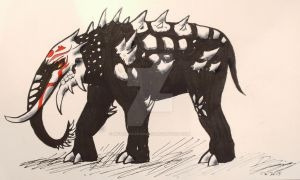
Or they could hit us with giant mecha structures à la Star Wars, a project G.I.A.N.T that Watts is all too ready to hack into and turn against the Atlesian military. I’d keep my eyes open for any giant allusions in Atlas’ arsenal, chances are they’ll be playing an active role plot-wise.
Which brings us now to the themes. As stated above, the main themes of satire are darkness, dissolution, the return of chaos, and the defeat of the heroic figure. We can surmise that Atlas will be the lowest point in RWBY. Frye goes as far as link winter to “Götterdämmerung myths” aka the fucking Ragnarok. Wiktionary has a second definition for Götterdämmerung which is a “cataclysmic downfall or momentous, apocalyptic event, especially of a regime or an institution”, so yeah we’re going to see the Atlas regime full on collapse as chaos takes over in there. Team RWBY will experience its must crushing defeat. My guess would be that, after Mistral establishing Ruby’s powers and having them bring a note of hope to the narrative and the upcoming battle against Salem, Atlas will be about the limits of those powers. I think Ruby is about to face the reason Summer died and lose to it, aka the Fenrir of this Ragnarok but this is a whole other theory I might delve into in a separate post since this post is already running too long and Atlas and its connection to Norse Mythology deserves to be delved into in detail. But yeah Atlas will be on SOME shit, my dudes.
-Vacuo is summer, so Vacuo is a romance. The subordinate characters here are the companion and the bride, so basically the lovers are at the center of the narrative here. As far as RWBY goes, 3 pairs of lovers have thematic and narrative importance: Salem and Oz, Jaune and Pyrrha and Yang and Blake.
So now that the Adam subplot was carried to an end in Mistral, and after the narrative centers more around Blake, gives the Faunus cause more depth and prepares her for her future role as a leader in Atlas, what does that leave Bumbleby with narratively in Vacuo, especially Yang? The one remaining hanging thread by then will be Yang/Raven, which prompts me to believe the bees will be confronted to their foil as a relationship, a.k.a Taiyang/Raven, making the latter the fourth lovers pair to mark this arc. Taiyang and Raven coming back into the narrative at this point means we’re gonna get insight about another lover of Taiyang’s, Summer. I think Vacuo is where we’ll get all the answers wrt to Team STRQ, and after witnessing for ourselves how she died in the Atlas arc, we’ll get flashbacks of how she lived in the Vacuo one, which will be the thing to propel Ruby again after losing heart in the wake of the absolute apocalypse I expect Atlas to be. I also think CRWBY would get a kick out of having Summer be a major narrative force of the summer arc in the story.
I personally am a believer of the Spring Maiden!Yang theory and I think there’s enough set-up for it, mainly:
The fact that out of all the students at Beacon, the only contenders for the Vytal Festival by the end were Pyrrha and Yang (who only got disqualified because of the Mercury ordeal)
The way Yang is always set up as the strongest out of team RWBY
Raven was established as a foil to Blake but V5 establishes her as a foil to Yang, which culminates in their confrontation at the vault
The part of her confrontation with Raven where she establishes that not only is she stronger than Raven, but readier to face Salem and thus more fit to have the Maiden powers, which is why she’s the one that retrieves the relic from the vault. Raven might be the one to open the vault but she never gets inside. CRWBY could have had the confrontation happen after Raven retrieved the relic from within but they didn’t and I think it’s significant how Yang is the one allowed inside the vault and to handle the relic first, as if it’s always been her rightful place.
Which means I fully expect Raven to die at this point of the narrative. There’s a part of their confrontation where Yang tells Raven about the version of her Tai told her about and the one she’s always held out for, and she asks her if she killed her, too. It’s the thing that strikes Raven deeply and completely shatters her composure as she finally runs out of excuses and has to face herself and what she’d become. I think it’d be symbolically powerful to have Raven align with and die for the just cause, thus resurrecting that version of her.
For the remaining two pairs of lovers, Salem/Oz getting a conclusion in the last act of this story comes as no surprise, as for Arkos...tbh I don’t really see anything there (yet).
As for the themes, summer is for triumph, the messianic hero defeats the enemy who is associated with winter, darkness and moribund life (if there ever was a way to perfectly describe Salem this is it). Summer ends with an achievement, usually a marriage.
Now, out of the four pairs of lovers precited, I wonder who the ones getting constant and consistent development still and all throughout the story, are both alive by the end and have been shown to get growing awareness of their deepening feelings could be?
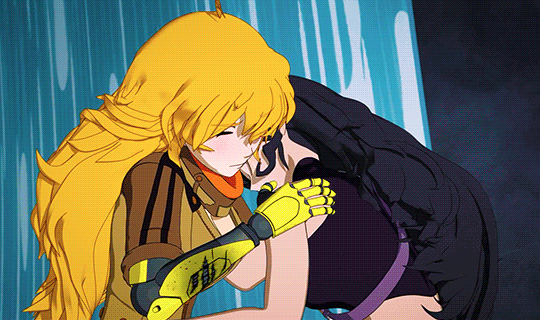
I wonder...
;)
P.S: not saying the bees get married married but yeah I expect them not to get their kiss till Vacuo. I think too much will be happening in Atlas (V7-9) for them to actually get together so they’ll be in this...limbo of not-really-lovers but definitely-more-than-friends and we’ll see them getting increasingly closer (they’ll prolly also blueball us big time with grade A pining) but again I did not expect Adam to die as quick as Mistral so who knows
#rwby#rwby6#rwby7#rwby predictions#james ironwood#ruby rose#yang xiao long#blake belladona#weiss schnee#jacques schnee#my meta
596 notes
·
View notes
Note
im new to shokugeki and i dont care about spoilers, why is it bad?
a no joke answer bc u deserve this:
tl;dr Shokugeki sucks because it lost its direction halfway through the story, and when Tsukada (the author) realised that he’d bitten off more than he could chew with such a huge cast of characters.
long answer:
here’s the thing. Shokugeki started out good.
it mostly played off the usual shounen tropes: a challenger would appear, but then they quickly joined the friendship circle, rinse and repeat. but with such a wide cast of characters with differing goals and personalities plus the high stakes of only the top 10% graduating, it made it easy to bank on the character interactions and friendships, which is what the first half of Shokugeki did, heavily so. and it worked !
it was a simple set up (protag aims to beat his dad in a cook off, goes to cooking school, meets friends and foes ! a tournament arc ! fun and shenanigans ! yay!), but Shokugeki did it good. it didn’t subvert any expectations, just did according to what it set out to do. nothing felt exaggerated beyond the typical manga stuff, and everything achieved was earned with hard work. with the occasional fluff and friends thrown in, it became a comfy mix for a good shounen manga.
if anything, id say that half the success came from the character’s relationships themselves - the plot wasn’t anything special, but the genuinity that the characters and their friendships and goals (shared or not) were treated with were wholesome and fun.
which is why it was so fucking jarring when it derailed by throwing aside half of its cast and completely stagnating all character development for the remaining half.
(insert infamous Central Arc expulsion joke here)
if you’ve started/are intending to start, id say its the most obvious after the Moon Banquet Festival Arc/beginning of Central Arc. the writing started getting sloppy, as did the handling of the characters. ive mentioned this before, and ill stress this again: i honestly believe that Central Arc is when Tsukada realised what a big miss steak he did in creating such a huge cast, and in the face of Shokugeki’s then success, made some poor authorial choices to keep the hype going (both plot and character wise).
for characters: half the cast was rid of via expulsion, including very competent chefs (which had no proper in canon explanation on how the fuck that happened) who happened to be fan favourites. i mean, Hayama Akira ? fuck, Nakiri Alice, anyone ? plus any poor remaining characters got shafted in lieu of Souma, hard. this became more prominent as the Arcs slowly go on, the ones of which took the worst brunt of it being Takumi and Megumi.
(what do u think is worse. your fav never getting a cameo or your fav being part of the forefront team but constantly getting fucked over because Souma didn’t get the spotlight of the chapter yet. vote now in the replies.)
for plot: higher and higher stakes were introduced that again, just didn’t make sense !! in Central Arc, Souma was expected to win against Eishi, the best chef in his entire school. when two arcs prior he just lost a cooking contest to two of his peers (placed third), and one arc prior struggled to beat Kuga in ticket sales (even then he didn’t win because his cooking was better, so. wasnt even a win on the cooking front). there was no build up ! NOT EVEN A TRAINING ARC. he just went straight from the bottom rung of the ladder to the fucking ceiling. super different from the first half of the series when everything would be shown in careful detail (best example i can think of off the top of my head being the Shokugeki against Mimasaka in the Autumn Election Arc).
also: in the midst of introducing Erina’s character arc and backstory, Tsukada seemed to completely forget (or maybe just didnt know how to link back?) that he’d already established an overarching plotline: Souma’s quest to best Jouichirou. so when Souma began overthrowing these foes that are his seniors said to be leagues ahead of him, the suspension of disbelief was stretching waaay thin. but hey ! its a shounen manga ! we can forgive this much (sarcasm).
then Tsukada introduces Asahi. mother fucking Asahi. who is basically introduced by beating Jouichirou without breaking a sweat, but oh boy did he break the suspension of disbelief right then and there and completely toss the plot into the fucking fire. because there’s no end goal anymore ! the one thing that our main character has been working so hard for ? non existent. pointless. this no name (at that time) character has done it, pack your bags boys, let’s go home.
(might i note that at this point, Shokugeki was also uuhh nothing like the slice of life comedy it originally was. it became an action-psychological mix that just…doesnt work. and i mean. of course it wouldn’t. there was no foreshadowing, the villians can’t be taken seriously because 1) theyre also teenagers for fuck’s sake 2) Azami’s just a creep, plain and simple. he has no depth. no one cares about an antagonist who’s bad at just being bad.
the themes it began with was completely set aside for really badly written character backstories and angsty edgey bs that i still don’t understand why Tsukada thought would work in retaining hype. especially when considering how pure the premise was.
i honestly also think that its the Blue Arc + Dark Chefs Arc when Tsukada actually realised that his plot had gone haywire, since volume sales were dropping hard and fans clearly hated the direction the series had gone in. but instead of trying to reign it back in, he decided to just let it run buckwild because he just didn’t know how to fix it.)
to rub salt into the wound: so many promised resolutions are shoved into the background, done offscreen, or worse yet, forgotten ! scenes that fans have literally been waiting for. Souma VS Erina Shokugeki. Souma VS Takumi Shokugeki. Nakiri Alice coming back to the series and actually fucking cooking again.
(im sure that there’s more that lead to its downfall but like. shrugs. this is mainly to me why it sucks: it had A Lot going for it (im not ashamed to admit that at one point i actually genuinely believed it could be one of the next Big 3 on Shounen Jump), and it just didnt live up to any of it for no other reason other than Tsukada mixing elements of a story that didn’t work well together, tried to force them to work, and did nothing to fix it when it didn’t.)
so our plot is gone. so are our lovable characters. so is the slice of life comedy that drew most people in in the first place. the potential that it had is now dust. what does Shokugeki have left that makes it unique, that makes people love it ? here’s the answer !
nothing.
that fact kicks you in the teeth every fucking time you remember how good the first half of the series was.
then that fact dropkicks you when you realise that Shokugeki no Soma literally started on a 90degree drop into a dumpster fire when the series was at the apex of its popularity and plot buildup.
that’s why it sucks.
#shokugeki no soma#shokugeki no souma#shokugeki still sucks. change my mind.#shady business#long post
62 notes
·
View notes
Text
Beyond The Black Rainbow, 2010
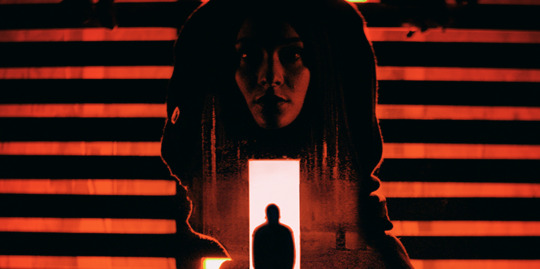
Release Date: May 18, 2012 (USA)
Director: Panos Cosmatos
Link: https://www.youtube.com/watch?v=nWF0bBKhe6o&t=1s&frags=pl%2Cwn
Beyond the Black Rainbow, also known as the worst film to ever watch while tripping on any type of hallucinogens, will go down as one of the strangest, yet insanely visually stimulating movies of the 10s. It’s safe to say that this sci-fi horror film did not fall short in regards to its genre, as it is filled with science and an amped up perspective on the normal level of unnerving horror. To this day Beyond The Black Rainbow is either hated or strangely loved by its viewers. After reading this review you will soon understand why...
Based on the strange and unsettling time period that the year 1983 fell under, Beyond the Black Rainbow is a film based off of the feeling of having completely no control over your senses. From the characters themselves experiencing this traumatic feeling of being held hostage in the most literal sense. As the protagonist, Elena, finds herself being held captive by the young protege of Dr. Arboria, Barry Nyle. A charming, yet psychotic scientist who has been keeping Elena under his constraints due to her psychic abilities. A power in which Dr. Nyle has the power of controlling with a glowing prismatic device.
In an effort to understand Elena and her powers, Dr. Nyle conducts daily therapy sessions while she is either heavily sedated or on the fine line of being so. Furthering his knowledge on her telekineses in order to use her abilities for himself, as he frequently subjects them onto others throughout the movie, Ultimately leading to most of their demise.
It is within the middle portion of the film that emphasizes Elena’s desire to escape Dr. Nyles firm grasp. Other advances such as the reasoning behind Dr. Nyle being the psycho that he is are also displayed. The backstory behind Nyle being as posessive as he is over Elena lies within his own journey towards reaching what his mentor, Dr. Arboria’s, main goal was for his institute... transcendence. In order to reach this level of superiority Arboria had put Nyle through a procedure that would in a sense open his third eye.
It is within this flashback that the truth comes to the forefront and all things begin to finally make sense. Given that the whole reason Elena is stuck under Nyle’s control is due to her father actually being Dr. Arboria, and she too had succumb to the same procedure Nyle had gone through. Making them connected, yet at the same time making her the one with the stronger powers given how young she was when this all went down.
From this point on the overall theme of the movie takes a very dark turn and is then based around hallucinations, unearthly looking creatures, Dr. Nyle being one of them.
However, Elena eventually ends up being able to finally escape out of the institute that up until then was the only thing she knew. It wasn't long before Nyle would come chasing after her, just to meet his own downfall, as Elena is finally able to break through his control and use them for her own benefit. Which could only be Nyle’s monotonous death.
Overall this movie was filled with disturbing visuals, along with eerie scenes that could keep the mind up for days on end. Although the plot was slowly developed thanks to the lack of dialogue at the very beginning, the end result was still in fact shocking and worth the watch. I can assure you that I have never experienced a movie such as Beyond The Black Rainbow.
Some of the overall themes depicted can be subjective for the viewer. However, the ones dually noted are the social control mechanisms, internal controls, and the effect of religion has on our perspective on society. Given that the film expressed deep interest in making sure that the viewer felt uncomfortable while having no control over what they might have thought to happen next within each and every scene, as well as what horrifying imagery they’d see next. Along with the constant repression and lack of control one could feel while sympathizing with the protagonist, Elena.
8 notes
·
View notes
Text
The Advent of Johnlock
So, I saw someone refer to Jefferson Hope and Faith Smith in the same post and some ideas kinda clicked into place for me, about why it was always going to be the fifth series in which we get canon Johnlock. This is my first meta, I’m not sure on structuring it, but I think this is the most logical way. So here we go!
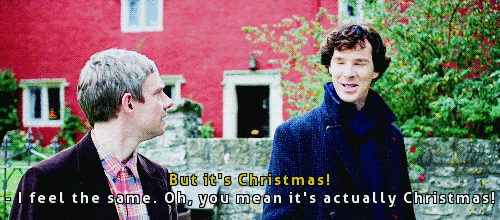
Content warning: I’m going to analyse religious metaphor in this meta. If you’re very strongly Christian, some of the things I say you may find offensive. I mean no offence to anyone’s religion and respect all views - I am merely describing metaphor as I see it.
As someone brought up in Church of England, for me every Christmas came with the anticipation built by the four week long season of Advent. Advent is a time of preparation for the day of celebration, to think back on out past selves and improve, to prepare our hearts for Jesus.
Now bear with me, because this going to seem a little crazy until I unpack it. But my point here is that the first 4 series’ of Sherlock are the 4 weeks of Advent. Series 5 will be Christmas.
“Advent is a season of expectation and preparation, as the Church prepares to celebrate the coming (adventus) of Christ in his incarnation”
https://www.churchofengland.org/prayer-and-worship/worship-texts-and-resources/common-worship/churchs-year/times-and-seasons/advent
We already see religious metaphor in Sherlock - “Lazarus is go” is an example that springs to mind, and there’s the whole rising from the death situation. I could write loads about candles and light/dark symbolism too, but that’s a little much for now… We’re going to focus on the traditions of the Advent Wreath and the Four Last Things as our points of reference here. I’ve used a couple of sources, but there is a lot of different interpretations of the meanings of the 4 weeks of Advent and I’m basing this meta on the ones I grew up with, which doesn’t ally with all sources.
Just in case people aren’t familiar: an Advent Wreath is a set of 5 candles, one lit in each week of advent and the last on Christmas day, each symbolising a Christian value. As I mentioned before the order changes across the religion, but in the Church of England I grew up with Hope (Christ’s coming predicted by the prophets, our ancestors), Peace (the angels), Joy (the shepherds), Faith (the wise men), and Love (Jesus). The Four Last Things are themes for meditation during the season: Death, Judgement, Heaven and Hell.
Series 1, the first week of Advent: Hope, the Prophets, and the theme of death.
Immediately, Jeff Hope. Obvious!

But also, the themes of the series; John is hopeless, thinking about death. Sherlock gives him hope.
Of course, death is a constant theme through the show, but in particular this series, where they choose to die together with a glance.

And haven’t people seen Johnlock in ACD canon for decades? Centuries? Our forefathers of fandom saw this coming, and had hope for canon Johnlock. The first Sherlockians are our prophets and ancestors.
Series 2, the second week of Advent: Peace, the angels, and the theme of judgement.
Here, judgement is the obvious one. The Reichenbach fall is full of not only a literal trial where Moriarty is judged, but focusses on the media and public opinion’s judgement of Sherlock and John as people. Is Sherlock a good person? We as an audience are instructed to question him, by Moriarty, who sits in a throne of judgement. Literally.
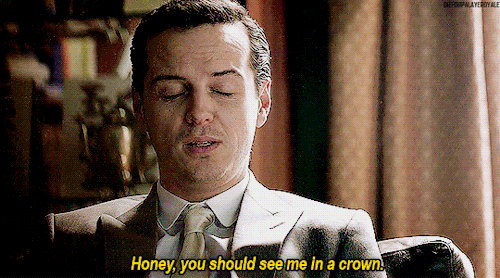
Peace is more tricky. At a surface glance of the show, where does peace come into it? But when we look at inner peace maybe; this series is in some ways the most domestic between John and Sherlock - they fight, yes, but look at the small scraps they have compared to the wars they fight in series 4. They find peace in eachother’s company.
Peace is also what the struggle is all for; look at Sherlock, sacrificing himself, his life, his work, for his friends. But the failure to grasp that peace is an unreachable concept - heavenly, impossible on earth - is no doubt his downfall… literally. His sacrificing himself does not give his friends the peace he desires for them. The only peace found in the series is during their domestic moments in Baker Street, AKA when they actually communicate.
Angels of course link to Sherlock’s death, he may be on the side of them but he’s not one of them. He’s mortal. He must be, to die and rise again. And again and again, in different interpretations of ACD canon. Sherlock is mortal but can’t stay dead. He has unfinished business in his stories. The end isn’t right yet. And cupid, the eros statue at the start of ASIP, shows us right from the start what the angels mean - Sherlock’s unfinished business is announcing his feelings for John.

There’s another thing and it’s probably a bit of a stretch. I’ve always wondered why the scene in THOB where Sherlock apologises to John takes place in a graveyard, distinctly an English country church graveyard. Weird choice, right? Maybe we’re going for religious metaphor? And then we get John as a conductor of light. Now, Sherlock is Jesus, he rises from the dead, and believes in a higher power - himself. John is an angel then, who magnifies the Lord? John is the disciples, who follow Jesus with steadfast faith and trust, wonderment and awe, who follow his commands without question… usually. John is the name of one of the disciples, one of the fishermen who became a ‘fisher of men’, someone who recruited more followers of Jesus. What did John’s blog do if it didn’t recruit believers in Sherlock, especially after he fell, with the Empty Hearse society and people such as that? Maybe that is reading too much into it, but enjoy how smug Sherlock would be at being compared to literally God.

Series 3, the third week of Advent: Joy, the shepherds, heaven.
Weird to associate joy with this series of pain from the perspective of Johnlockers, who have suffered so much at the hands of this series, but hear me out!
Sherlock comes back from the dead and is no longer aiming for peace for his friends. He is much more focussed now, and, in fact, realistic, although still off the mark somewhat. He is determined to give John a life of joy, with the woman he chose to marry. He creates all kinds of chaos (shooting Magnussen a notable example) to secure John’s happiness.

Shepherds guide and protect sheep, an animal with inferior intellect but that they care for nonetheless - you see where I’m going with this. Sherlock tries to shepherd John’s life into order, but then, as in the Christmas story, angels - Sherlock’s call to tell John how he feels, or face endless death and resurrection - in the form of his exile go to take him away. Up to the sky in a plane - heaven - oops, not quite. Back to Earth again. Sherlock can’t get into heaven until he does what he was brought back to life in this reincarnation/adaption to do: confess to John.
The Bible tells us that a wedding banquet is a foretaste of heaven, and here at John’s wedding banquet he gets an admission of fondness, and almost confession of love, the closest Sherlock has yet got - “a foretaste of the heavenly banquet".

No Sherlock, you definitely haven’t finished yet.
We get told as Sherlock’s plane comes in to land that “there’s an East Wind coming” - SherlockJesus is coming to pluck the unworthy from the Earth. We get that you like Sherlock, Mofftiss, but did you have to make him so transparently GOD??
Series 4, the fourth week of Advent: Faith, the wise men, and hell.
I make no secret of the fact that I’m less familiar with the fourth series, so if anyone would like to add any points here (or anywhere else to be honest) I’d love to hear more analysis.
Faith, again, a transparent one, Faith Smith.
The wise men are famously from the east - the east wind has arrived, with gifts fit for a king: an elaborate game for Sherlock to solve. But also causing accidental death - the wise men told Herod about Jesus, causing him to slay all the male babies in the kingdom, and Mary’s death happened because Sherlock returned, and why did he return? Eurus/Moriarty’s plans, the east wind, the wise men.
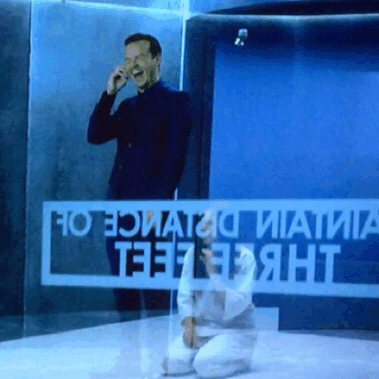
There are traditionally three wise men - three parts to the east wind. Eurus, Moriarty, and… Mary? That’s speculation. This needs more thinking about.
Of course, hell - we’ve all been in Johnlock hell for years now, but that’s not really relevant to this series. What IS relevant is that SHERLOCK is now in Johnlock hell - he’s putting himself through it, perhaps, but watch as he is punished for not confessing to John and John is hurt by Sherlock’s actions because of his aborted attempts to confess.
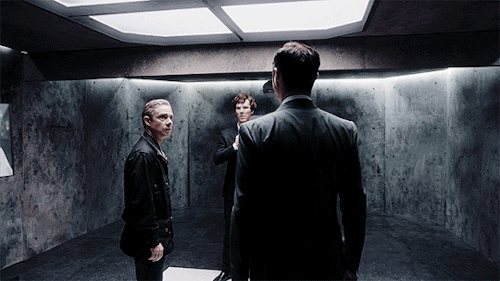
TFP shows Eurus’ games, which put Sherlock through the nightmares of those he loves being hurt. A private hell, built just for him. Or perhaps a purgatory, which after he suffers through it brings him close to heaven/Johnlock.
And Series 5, Christmas Day: Love, and Jesus.
Here we will have Christmas, with a present for everyone that we’ve longed for for generations: Johnlock becomes canon! The theme of love, of course, will be heavily present, and Jesus/Sherlock will at last be free of his earthly purpose - to come down, free us from the binds of Johnlock hell and ascend to a peaceful resting place, where his disciples/John will join him in the wedding banquet of heaven.
Well that’s that, my first attempt at meta! Once I wrote it out it got longer than I was really expecting, but I hope you all got something from it, and let me know if you also see an religious/advent metaphor in the show :)
#meta#johnlock meta#sherlock meta#sherlock#johnlock#tjlc#my metas suck#asip#tbb#tgg#asib#thob#trf#teh#tsot#hlv#tld#tfp#some thoughts and stuff#what else can I tag this as#john watson#Sherlock Holmes
26 notes
·
View notes
Text
Week 17
What would have been my busiest week turned out to only be three days, but they were intense enough!
Monday: We were back in university for a day divided between two topics: job applications & interviews and the classics in the classroom (that’s some top-notch sibilance there). The contrast in these two topics was much appreciated. I was thoroughly inspired by the classics talk. At my current school KS3 have fortnightly lessons called Let’s Think in English where the teacher reads a texts, pausing at points to give information and ask questions. They then pause before the climactic moment in the text to ask key questions which are discussed in pairs then as a class. The students love these lessons as they think they aren’t doing any work HAHHAAHA little do they know. There is no writing and very little reading involved. The lesson revolves around listening and discussion; two activities which the talk on classics also celebrated. I enjoyed this talk because it helped me understand why I felt these kind of lesson/activities are so important. Firstly, two of the key skills in life that all people need are listening and discussion. Secondly, lessons which heavily involve these skills level the playing field to an extent. Lessons are so often writing focussed and, as I’m sure many teachers are aware, many students can talk the talk but sometimes can’t write the talk (..?). There are of course students whose English language skills are under-developed due to speech difficulties or having recently arrived in the country, but this doesn’t mean that they shouldn’t be heard or allowed to be part of a discussion with those who are eloquent. Equality to all voices!
Lessons taught: 1x Year 10 - ‘Afternoons’ by Philip Larkin. 3x Year 9 - Reading through Chapters 5, 6 & 7, practising essay writing skills. 1x Year 8 - Media/Film lesson on the theme of surveillance, my University Tutor observed lesson. 1x Year 7 - Planning and writing for a vlog.
That’s only 6 lessons but it felt like a lot. Unfortunately I didn’t go to any Year 12 lessons this week because in the first one they had an exam conditions essay writing lesson, the teacher was absent for the second one, and the third one would have been about right now but it’s a snow day.
Year 10: another successful lesson where most students made notes and about 30% contributed. I was doing a lot of the work though and am planning to change this pattern next lesson. I was supposed to teach Emily Dickinson’s As Imperceptibly as Grief today and I had some exciting activities up my sleeve but alas, they will have to wait until Wednesday now. I was going through the SOW that the teacher gave me and found these comments in the ‘context’ slide about E.D:
‘She is sometimes depicted as a solitary genius as she rarely left the house, but in fact she was quite sociable and often entertained visitors.
Her poetry was only ever really about her home and the surrounding countryside.’
‘only ever really’; what a shocker!!! I have been reading Open Me Carefully this morning which is a compilation of the letters E.D sent to Susan Huntingdon Dickinson, her sister-in-law with whom she shared a ‘deeply intimate and passionate relationship’. I have since changed the comment on this slide to:
‘She is sometimes depicted as a solitary genius as she rarely left the house, but in fact she was very sociable and often entertained visitors. She had 99 correspondents over her lifetime.
Her poetry tackles themes such as mortality, grief, freedom, faith, identity and nature.’
Safe to say I am quite excited about this lesson.
Year 9: Animal Farm is not as exciting as I’d hoped it would be. Of course it is interesting, as an extended metaphor, a fable, a polemic; but the ‘literature’ element is secondary to it. The teacher said she had considered studying To Kill a Mockingbird with them and I think that would have challenged and engaged both them and myself more. Oh well. I introduced them to the word ‘polemic’ this week. I got them to form an opinion continuum across the room as to whether they thought Animal Farm was a fable or polemic or somewhere in between. A lot of them bunched in the middle but at least it was something a bit different for them to do!
Year 7: I just had the one lesson with them this week. I gave them a checklist - ‘features in a vlog’ - and go them to note down the features as I played a travel vlog. I paused the video at key points and got them to identify the features. It worked well. Some of them were noting down features straight away, some noted them down when I paused the video and some needed prompting/questioning in order to identify the features. I then showed them a template that they could use to write their own and set them off. They were writing these in groups of 2/3. When I went round to help them quite a few were off task. I quickly worked out that when I asked them to perform what they had so far this really spurred them on because they LOVE performing, being the centre of attention, being heard. Unfortunately I missed the lesson where they performed these to the whole class. On Monday we are in a computer room with them and I might try and record them and add images to a video. My technology skills might not be quite up to the task but I will liaise with the teacher and try my best.
Year 8: Observation lesson! I think I benefitted from the ‘honeymoon’ period in terms of behaviour during this lesson, as I’d never taught them before. I managed to learn a surprising number of names, even the name of the boy who appeared in the room despite not being on the register or seating plan! It remains a mystery as to why he was in the room. About ten minutes in a quiet boy put his hand up and said ‘miss, he isn’t supposed to be in here.’ Luckily my AT was at hand. The boy said he’d been moved tutor groups but no one, including the class teacher, has found any evidence of this. Anyway, he stayed in the room for the duration and caused a moderate amount of disturbance. The topic for the lesson was surveillance in relation to the film The Truman Show (or if would have been in relation to this film if I’d gotten to the plenary). It was the first time I’d taught a lesson on media/film but I had read the entire SOW so far in preparation and watched some videos on Youtube about the basics of film/media classes. As I look back on it now I wish I had chosen a different topic. I just chose the next topic in the SOW but it didn’t really work in my favour. The text’s reading age was too high, I didn’t model answers to the questions I posed and I didn’t feedback from the questions. The starter/s were more successful in terms of engagement but the content didn’t quite link. I would have liked to come in with something a bit stronger and more personal for my first lesson with them. My main downfalls: I didn’t ask for help with the lesson early enough and I didn’t question the SOW provided. My goal over the next 7/8 weeks is to develop confidence in picking my own topics/ideas/activities for lesson and following through on questions like; what do I think is important? what do I think they need to know?
Next week I really need to get on the EPS boat. My presentation for the assignment will be on questioning. I chose this topic because I really want to develop my own questioning skills and believe that in the classroom situation, great questioning makes all the difference. I am worried that I won’t be able to identify a solid question in the topic though (ironic). What is the impact of good questioning? How does good questioning affect learning? How do teachers construct questions? What kind of questioning techniques build students’ learning? How do I measure these? A challenge. I guess I need to ask for help, and in good time.
Onwards and upwards. I’ve got to plan, deliver and mark multiple assessments over the next two weeks and try to get my lesson plans in earlier as my bad habits aren’t proving conducive to building good relationships within the English department.. :( with whom I still do not share an office with. Oh well!
Happy snow day one and all! Please enjoy my cartoon strip of life so far in Placement 2 as a final word:

1 note
·
View note
Text
Backcross Ancestors: Planetary Powers
Hey, remember last year’s Alphabeta Ancestors? Well, since then I’ve come up with quite a few new ones that haven’t really gotten much airtime! Most are tied into the history of Dunox or the Chymicas, so... that’ll be our theme for this week, I guess.
Profiles, descriptions, and links under the cut!
Hedres Yuan-ti, ancestor of Viidan Yuan-ti. Lady Dualinox the First, ruler of Dualinox Twinsuns. Beautiful, fiery and ambitious, yet patient in the extreme. So patient, in fact, that she willingly forswore her natural claim to the throne in order that her descendant might instead be better trained for it. Unfortunately, she was assassinated before she could carry this out.
Phoebe Hastas, ancestor of Abisal Hastas. The Huntsman, one of Hedres’ most trusted generals, who never lost a quarry. Emotionless and silent, her true allegiance was always a mystery, until she was discovered to be protecting the known rebel Leslie Shieda... and both were executed.
Audrin Worthe, ancestor of Marcus Worthe. The Biomechan, a scheming violetblood known for his experiments combining the biological and mechanical. The youngest and last of the old guard on Dunox, he’s fighting hard to bring the world more in line with the traditional hemospectrum, longing for “good old days” that never really were. But he hasn’t always been so radical in his ideas...
Arevas Ardini, ancestor of Zandra Ardini. A quiet healer who refused to keep their title, and spent their last sweeps regretting the pain they’d caused and the troll their descendant turned out to be, before possibly being killed by said descendant. Formerly a leader in the Imperial army, Arevas led several invasions, believing fully in the doctrine of the Empire. They never enjoyed violence, but it was a means to an end.
Leslie Shieda, ancestor of Del Shieda. A lowblood rebel with wind powers, who used to be a hell of a lot more radical until her descendant was hatched. Then she tried to settle down and stay under the radar, to raise him, along with Phoebe’s descendant Abisal, who was about the same age. Needless to say, the peace and quiet didn’t last long. She always was born to be a fighter.
Non-Dunox:
Jantre and Miruus Alkayn, ancestors of Laurin and Aannaa Alkayn. A two-headed troll usually referred to as Januus, The Two-Faced King, and ruler of the heavily mutated, medieval system known as the Chymicas. They’re extremely xenophobic and isolationist, partially because so many Chymicans, including themselves, are in danger of being culled by the Empire at any time it pleases.
Ryotai Himaka, ancestor of Kiyoru Himaka. Maverick Black, an outspoken rebel who refused to follow just about every troll convention there was, starting with gender. Her one exception was that she was a hopeless romantic - and that, in the end, was her downfall.
Jesiak Markem, ancestor of Zakiya Markem. In an alternate timeline he became the Marksman Mutineer, a slave trader who used his silver tongue to take his ship from its captain and afterward stay in the Empire’s good graces while being just about as far from lawful as he could.
Lettel Inocem, ancestor of Vir Inocem. A troll who always felt too much, ey survived to adulthood by keeping eir head down and doing everything ey could for other trolls. So, ey had absolutely no idea what to do when ey became a rainbowdrinker.
Althis Thalra, ancestor of Soltra and Pehira Thalra. The Librarian, a peaceful limeblood who curated an extensive, honeycombed labyrinth filled with the knowledge of his cult. Until, that is, all limebloods were sentenced to execution - and the library was burned.
#fancestor week#lizard speaks#Lady Dualinox#Huntsman Hastas#The Biomechan#Arevas Ardini#Leslie Shieda#Januus Alkayn#Maverick Black#Lettel Inocem#The Librarian#Marksman Mutineer
2 notes
·
View notes
Link
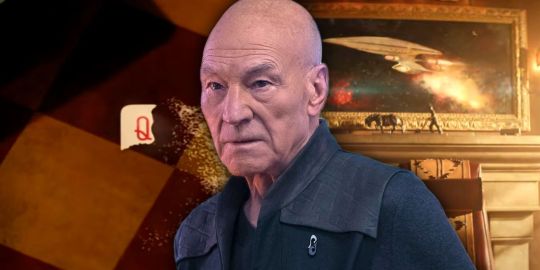
The first Star Trek: Picard season 2 trailer is packed full of exciting tidbits, including a huge reveal about the return of a major character. Star Trek: Picard season 1 premiered in January 2020, showing an aged and retired Admiral Jean-Luc Picard grappling with his own mortality, his rocky relationship with Starfleet, and his ongoing grief over the death of Data. Over the course of season 1, Picard was pulled into an adventure that included banned androids, ex-Borg, and a secret Romulan organization intent on wiping out all synthetic life in the universe.
Picard season 2 has been highly anticipated by fans and as part of StarTrek.com's First Contact Day celebration, a special teaser has been released to give everyone a first taste of what will be in the new season. The trailer features a voiceover by Jean-Luc Picard himself, played by actor Patrick Stewart, and is set to a remixed version of the show's theme. The main point of the voiceover is time: Picard discusses how unforgiving time can be, how it can create regrets, and offer no second chances, while the trailer offers tantalizing shots full of references to previous Star Trek shows.
Related: Star Trek: How Picard Ties In With Kelvin Timeline
Each shot of the trailer has hints about the new season, from small potential Easter Eggs to some huge story reveals. The biggest surprise by far comes at the end when it is revealed that Q, John de Lancie's iconic trickster character from Star Trek: The Next Generation, will be making a return as part of the cast in Star Trek: Picard season 2. In total, there are 12 major reveals that the trailer gives about the new season, enough to give fans plenty to talk about before season 2 premieres.
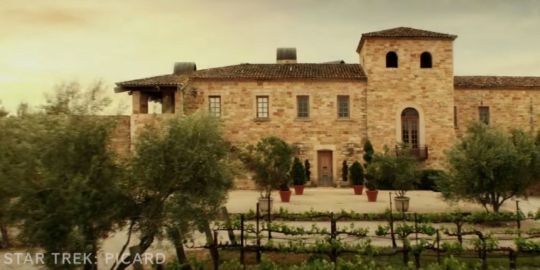
Picard's vineyard features heavily in the season 2 trailer, with the very first shot a slow zoom in on the house and grounds. Château Picard was first seen in Star Trek: The Next Generation in the episode "Family", and returned in Star Trek: Picard season 1 as Picard's new home after retirement. During season 1, Picard shared the vineyard with his dog, Number One, and two Romulan assistants, former Tal-Shiar agents Laris and Zhaban. While the vineyard only featured as a location in the first two episodes of season 1, its return in the new trailer suggests that fans will get a lot more scenes there in season 2. Hopefully, this also means the return of Laris, Zhaban, and Number One as well.

The first line of Picard's voiceover during the trailer states that "The true final frontier is time." There are several levels of significance to this statement, starting with it being a reimaging of Star Trek's iconic phrase "Space: the final frontier." This phrase was part of the voiceover heard during the opening credits of both Star Trek: The Original Series and Star Trek: The Next Generation, but by replacing "space" with "time", Picard almost seems to be challenging one of Star Trek's most well-known doctrines. Additionally, the fact that the trailer's voiceover deals so heavily with time indicates that Star Trek: Picard season 2 will deal with time travel, an important science fiction concept and something that the Star Trek franchise has explored before to great effect.
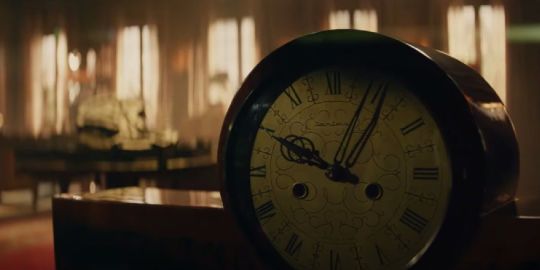
After seeing the outside of the vineyard, the next shot show's the inside of Picard's home office, focusing on an antique clock as Picard discusses how time can turn even the most impulsive actions of an individual into history. The link between the theme of time and the clock is obvious, and having it as the first thing viewers see in Picard's office only serves to drive home the point. It is possible that the time on the clock display could have some significance as well. The display reads 10:05, and although no connection to Star Trek: Picard or the wider Star Trek universe is immediately evident, it is certainly something for fans to speculate about.
Related: Star Trek: How Time Travel Works In Each TV Show & Movie
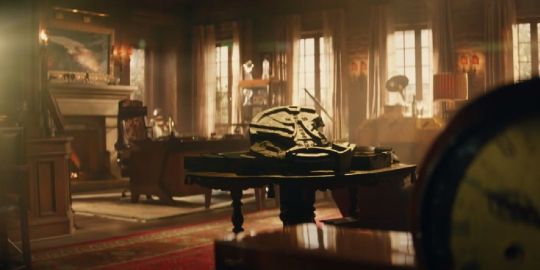
The shot of the clock also includes a brief but surprising look at the Reckoning Tablet, which is sitting on a table behind the clock in Picard's office. The Reckoning Tablet is an ancient Bajoran artifact that was first introduced in the Star Trek: Deep Space Nine episode of the same name. In the episode, the Tablet is discovered in an ancient Bajoran city, and while attempting to decipher the symbols on its surface, Captain Sisko accidentally breaks the tablet and releases a trapped Bajoran prophet and Pah-Wraith, inciting a war between the Prophets and the Pah-Wraiths as a result. The implications of the Reckoning Tablet in the trailer could be numerous, but above all, it suggests a return in Picard to storylines about both the Bajorans and the Dominion War, which was the central storyline for much of Deep Space Nine's seven seasons.

The next big shot of the Picard season 2 trailer is a few shots of a large painting of the USS Enterprise-D hanging on the wall. The final shot of the painting coincides almost directly with Picard saying the word "history", making it clear that Picard's history as Captain of the Enterprise-D is going to be even more important in season 2 than it was in season 1. Featuring the Enterprise-D so heavily in the trailer also could suggest that fans can expect more callbacks to Star Trek: The Next Generation and along with the return of Q, more cameos of beloved TNG characters.
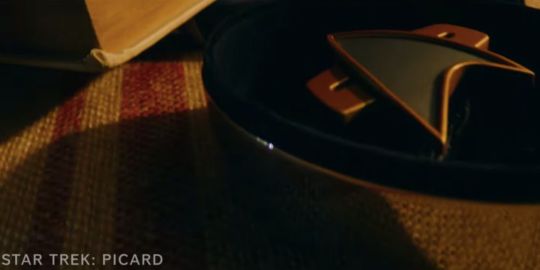
After the painting, viewers are treated to a shot of Picard's old com badge from his Enterprise-D days, sitting in a case on his desk as the camera pans over it. The com badge is immediately identifiable as the classic com badge design from the TNG era, as opposed to the newer, sleeker models that were shown in Picard season 1. The fact that Picard displays the com badge so prominently on his desk seems to show just how important his time as Captain of the Enterprise-D was to him.

The next shot shows an antique edition of Paradise Lost by John Milton sitting on the desk near to com badge. On the surface, this is a reference to Jean-Luc Picard's fondness for antiques, but it is also possible that Paradise Lost itself holds some significance. The work is an epic poem composed in the 17th century that deals with the Biblical stories depicting the Fall of Man, including the temptation of Adam and Eve and Lucifer's fall from Heaven. Star Trek rarely deals with religion directly, but the idea of man's downfall could definitely be connected to Q's return and his assertion from "Encounter at Farpoint" that humans are still a "savage, child race". Additionally, Star Trek: Deep Space Nine had an episode entitled "Paradise Lost" which dealt with Captain Sisko uncovering a plot to seize power from Starfleet and the Federation by a Starfleet Admiral. If the book is a reference to this, it suggests a dark plotline for the new season.
Related: Picard Season 2 Theory: Where Star Trek's Other Borg Are

Picard has a model of the USS Stargazer on his desk, the ship that was his first command before the Enterprise-D. Picard commanded the Stargazer for about 10 years and served on it for a number of years before that. The Stargazer's inclusion in the trailer further perpetuates the idea that Picard's past is going to be significant in the upcoming season, coupled with the references to the Enterprise-D and his voiceover about time. It is even possible that fans will get to learn more about Picard's command on the Stargazer, a period of time that has been reference before but never fully explored.
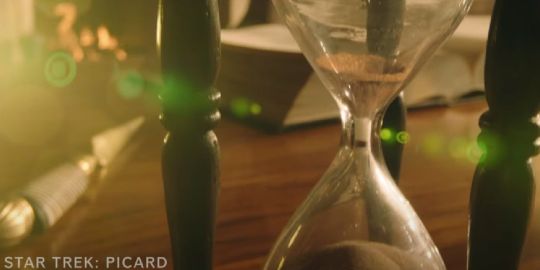
One of the most intriguing shots of the Picard season 2 trailer is a shot of an hourglass that appears to be going in reverse, with the sand trickling upward into the top bulb rather than down. When taken in the context of the entire trailer, especially the previous shots referencing important things from Picard's past, this shot all but confirms the idea that time travel will be a major storyline in Star Trek: Picard season 2. An hourglass in reverse suggests that the flow of time is being reversed, which would mean a return to the past that is likely going to be facilitated by Q. The concept of Q reversing, taking Picard back to his past to re-live his actions and mistakes was explored in the episode "Tapestry" from TNG, so it is very possible it could make a comeback in Picard.

One of the final shots of the trailer is an antique chessboard with two chairs and a stack of playing cards on it set up in Picard's office. Chess has always been a big part of the Star Trek franchise, although the traditional Star Trek chessboard was a more futuristic three-dimensional version. Along with the playing cards, which end up being the way the trailer reveals Q's return, the chessboard could be an indirect reference to Q as well, since in a recent Star Trek: Lower Decks episode Q made the crew of the USS Cerritos into chess pieces.
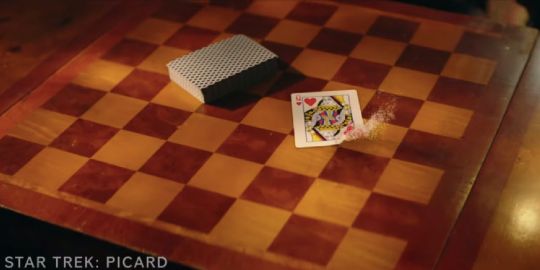
The last shot of the Picard season 2 trailer focuses on the deck of playing cards - in particular, the lone queen of hearts card sitting apart from the rest. The singling out of this card is a reference to the first episode of Star Trek: Picard season 1. In the first scene, during a dream sequence, Picard and Data play poker together, and when Data shows his hand all his cards are the queen of hearts. Although it seemed that Data's story had ended in the season 1 finale, this inclusion in the trailer could mean that more references to Data will be made during season 2.
Related: Star Trek: Data's Death In Picard Failed Geordi La Forge
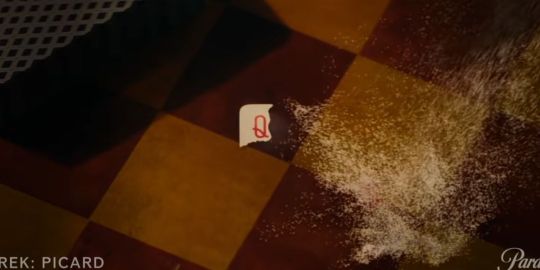
As the camera focuses on the queen of hearts card, the rest of the card dissolves away, until only the "Q" in the corner remains. The voiceover then switches to actor John de Lancie's voice, revealing that Q will be back for season 2 of Star Trek: Picard. Q is one of Star Trek's most iconic characters, and although he has made other appearances throughout the franchise, his return in Picard is especially exciting since Q and Picard's rivalry became hugely popular on Star Trek: The Next Generation. The chance to see it revived is a thrilling one for fans.
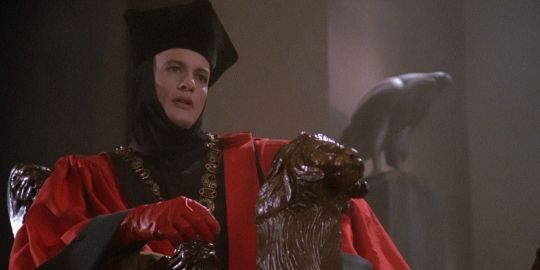
Q's voiceover consists of only one line: "The trial never ends." While the line is brief, its significance should be immediately aware to fans. The line is a direct callback to the same line in the series finale of TNG, "All Good Things...", where Q tells Picard that although he has been convinced that humanity can evolve, he will still be watching and judging their progress. The repeating of this line in the new trailer for Star Trek: Picard suggests that Q is back to his old tricks, and will likely find some significant ways to meddle with Picard and humanity in general in the new season.
Everything in the new trailer, from all the references to past Star Trek shows to the reveal about Q, suggests an extremely exciting new season for Star Trek: Picard. Along with the trailer, the main cast from season 1 has been confirmed to appear in season 2, and the announcement about Q hopefully won't be the last in exciting casting news. For now, fans will have a lot of talk about with all the Easter eggs, theories, and questions that the trailer has provided to ponder.
More: Star Trek: All 4 Shows Captain Picard Appears In, Explained
Star Trek Picard Season 2 Trailer Breakdown: 12 Story Reveals from https://ift.tt/3dAwdtv
0 notes
Link
How a Chinese website for pirated TV shows became a cultural touchstone for millennials But the site — one of China’s largest, longest-running and last-remaining destinations for pirated, subtitled foreign content — was shuttered on February 3 as part of a sweeping police clampdown on piracy. While the website is still live, none of its services work anymore. “I was heartbroken when I found out,” Liang told CNN Business. “I feel like there is one place fewer in China through which we can expand our horizons.” Police in Shanghai arrested 14 people they claim ran the website and app after a three-month investigation into suspected intellectual property infringement. At the time of its closure, Renren Yingshi had amassed over eight million registered users and was home to more than 20,000 pirated TV shows and movies. The site’s operators made some 16 million yuan ($2.5 million) in the past couple of years from ads, subscription fees, and selling hard drives loaded with pirated content, according to police. Renren Yingshi did not respond to a request for comment from CNN Business. The crackdown was lauded by state media and intellectual property experts as a sign of China’s resolve to enforce copyright protection — criticism over which has dogged Beijing for years. But it also drew a wave of backlash from fans who, like Liang, had long relied on the site for uncensored foreign content. An outpouring of support for Renren Yingshi dominated China’s Twitter-like Weibo platform in the days after the crackdown. Some thanked the site for “opening a door for us to the world.” The public outcry came, at least in part, because of how tightly the Chinese government restricts access to foreign content. It is one of only four countries or regions, alongside North Korea, Syria and Crimea, that doesn’t allow access to Netflix, the world’s most-popular streaming platform, for example. China also strictly limits how many foreign films can be screened in cinemas each year. And of the content that is allowed to air in the country, much is heavily censored. For Chinese millennials, watching foreign shows and movies is not only a favorite pastime — it’s an opportunity to learn about the world. And many of them say the roadblocks imposed by the Chinese government leave them with little choice but to turn to pirated websites, even though they are willing to pay for legitimate access to uncensored, foreign content. While the demise of Renren Yingshi and the country’s censorship crackdown suggests the status quo might not change, the reaction to its closure and the popularity of uncensored work shows that there remains a huge appetite for such content within China. Strict censorship rules Founded in 2003 by a group of Chinese students in Canada, Renren Yingshi — a phrase that means “everyone’s film and TV” — was born out of a desire to spread foreign TV shows and movies more widely within China. Young, internet-savvy Chinese were drawn to foreign content as China reformed its economy and opened up to the world. They found that such films and shows offered an edgier, more diverse alternative to the heavily censored content produced at home — as well as a way to learn about other cultures and societies. Getting access to that kind of content through legitimate means, though, is difficult in China. Since the early 1990s, authorities have allowed just a few dozen foreign films to be screened in the country each year — only nine of the 26 Oscar best picture winners were screened publicly in China from 1994 to 2019, for example. International streaming services, including Netflix, Hulu and Amazon Prime Video, have also been unable to crack the market. Netflix, for example, told shareholders in 2016 that the “regulatory environment for foreign digital content services” was “challenging” in China. A subsequent attempt to partner with a local company to distribute content failed. The content that is allowed to air in China, meanwhile, needs to meet strict guidelines. Movies or shows with controversial themes — such as those that depict China in a bad light, portray taboo subjects like the 1989 Tiananmen Massacre, or feature LGBTQ storylines — are kept out entirely. And since China lacks a film rating system, any content approved by Chinese regulators is heavily edited to remove certain scenes, such as graphic sex or violence. When the Oscar-winning Freddie Mercury biopic “Bohemian Rhapsody” was released in China in 2019, for example, any mention of the Queen singer’s sexuality — as well as his AIDS diagnosis — was edited out. And the American blockbuster fantasy drama “Game of Thrones,” which built its popularity on graphic sex and violence, was censored so heavily on Chinese streaming giant Tencent Video that some viewers complained that it was turned into a staid “medieval European castle documentary.” “There were too many ‘sensitive’ scenes deleted that I could hardly understand the plot anymore — it was so confusing,” said a fan of the show who watched on Tencent Video. The fan asked to remain anonymous because she once helped translate shows for a website that featured pirated content, and she also spoke to CNN Business about that experience. There’s little indication that these rules may change. Under Chinese President Xi Jinping, tolerance for foreign ideas and values has declined drastically. Popular Western culture is seen by Beijing as a key risk for foreign infiltration that targets Chinese youth — making such content important for the government to control. A long history of legal issues The sweeping restrictions have motivated fans of shows and movies that run afoul of censorship rules to subtitle them in Chinese and upload unauthorized copies online. They operate in loose networks of volunteer translators known as fansub groups. Renren Yingshi was among the largest of these networks, exploding in popularity as American series like “Prison Break,” “The Big Bang Theory” and “Gossip Girl” became smash hits in China. Long before the latest crackdown, Renren Yingshi was running into trouble with authorities. In 2009, it was one of more than 100 Chinese websites shut down for “rectification” after the government issued rules that banned the dissemination of unapproved movies and TV shows on the Chinese internet. At the time, Renren Yingshi vowed to give up its video downloading service, and in 2010 pivoted to translating open online courses offered by American universities. The strategy won the blessing of Chinese state media, which heralded the website as “a knowledge evangelist in the internet age.” That love-in didn’t last. The website eventually resumed offering pirated shows, and its servers were shut down by Chinese regulators in 2014, not long after the Motion Picture Association of America included Renren Yingshi on a list of pirate sites. It eventually popped back up, and at one point even moved its servers to South Korea for a time as it continued to look for ways to stay operational. Ultimately, Renren Yingshi’s interest in making money might have led to its downfall. While it began as a volunteer endeavor, Renren Yingshi eventually started accepting advertisements on videos, and charged members to view its content. “According to Chinese law, if copyright infringement was conducted for the purpose of making a profit, it is very easy to constitute a crime,” said Xu Xinming, an intellectual property lawyer at Beijing Mingtai Law Firm. Xu noted that in China, a business needs to make just a few thousand dollars in order to run afoul of copyright crime laws — well short of the millions police claim Renren Yingshi raked in. It’s not surprising, Xu says, that Beijing would want to go so hard against a platform with such a high profile. The government has worked harder over the last decade to address infringement, especially given Western accusations that copyright abuse runs rampant in the country. In 2020 alone, Chinese authorities shut down more than 2,800 websites and apps offering pirated content and deleted 3.2 million links, according to the most recent data available from the National Copyright Administration of China. ‘Using my love to generate power’ It’s not clear when the case may be resolved, though copyright infringement results in a punishment of up to seven years in prison, depending on the severity of the violation. Police in Shanghai did not respond to a request from CNN Business for more information on the case. No matter what happens to Renren Yingshi, though, it leaves behind a vast legacy of cultural exchange. “Many friends around me have grown up watching American series. They gave us a lot of extra parameters in our way of thinking,” said Lin, the Game of Thrones fan. She said she volunteered for a fansub group in high school called “Garden of Eden.” “If you’ve had so much exposure to different cultures, races and people from different backgrounds since a young age … it is easier for you to be able to see things from another perspective.” She said she was “using my love to generate power” — a phrase commonly cited by volunteers who want to emphasize that they are motivated by their passion for the shows, and not money. The translation work wasn’t easy, Lin said. “Every Friday, when the latest episode came out, the timer was on,” said Lin, who translated episodes of the American supernatural teen drama “The Vampire Diaries,” as well as sitcoms “The Big Bang Theory” and “Two Broke Girls.” Someone in the United States or Canada would record the show and send it along with English subtitles. Teams would then divide the episode into 10-minute segments and assign them to translators. “There was a lot of stuff I needed to look up,” said Lin, adding that it took her about two hours to translate 10 minutes of video. “Sometimes the characters would tell a joke that I couldn’t get, and I had to search for it online.” “It was difficult because I had to use [Chinese search engine] Baidu within the Great Firewall,” she said, referring to the government’s sprawling internet censorship apparatus. The work of fansub volunteers has effectively acted as a fourth wave of “translation activity that has had a huge impact on Chinese culture,” wrote Yan Feng, a professor of Chinese language and literature at Fudan University in Shanghai, in a widely shared Weibo post on February 3. By comparison, Yan said the other three major waves included the translation of Buddhist texts in ancient China, the translation of Western literature and social science works during the late Qing dynasty, and the translation of modern works on humanities and social sciences after the Cultural Revolution. For many Chinese millennials, fansub work is also a way to learn about the world. Many groups don’t just do translation work — they also add footnotes explaining background and context for certain dialogue to help Chinese audiences better understand historic, political or cultural references. “I think it’s a good thing for a child to be exposed to different cultures and different ways of thinking growing up,” said Joy Tian, a 23-year-old English teacher in Beijing. She said she was struck by the individualistic values at the center of many Western series and films, having grown up in a culture that emphasizes collectivism. “It helps promote diversity of thought,” she added. Xu, the Beijing-based lawyer, said it is up to the public to “do some self-reflection” following the crackdown on Renren Yingshi. “There’s no free lunch in this world, and they shouldn’t download or stream pirate films and TV shows anymore,” he said. But Tian stressed that she’d be willing to pay for the shows if they were uncensored. After all, she has paid for licensed American shows on legitimate Chinese streaming sites before — but she couldn’t get past all of the editing. Even Xu said that Chinese fans will likely continue to be tempted to watch pirated shows. People who watch such content and don’t profit off of it have not, traditionally, been punished in China. And if the government doesn’t ease up on its rules on content, the demand won’t go away. “This is indeed a problem. And as the government steps up its crackdown on copyright infringement, this problem will only become more acute,” Xu said. “With pirated access cut off, [the government and companies] should compensate by broadening legal access.” Source link Orbem News #Chinese #Cultural #Millennials #pirated #Shows #touchstone #website
0 notes
Text
♡ Brainstorming: Mind maps + Experimentation + Sketches
18 / 03 / 2020
Over the past two weeks we have done lots of varied different work shops and activities to help us in our research and idea development. Over the course of this time, I have come up with a couple of ideas for potential narratives. They are very vague at the moment, because they are just concepts, but hopefully once I am able to settle on one, I can flesh out the story and characters more.
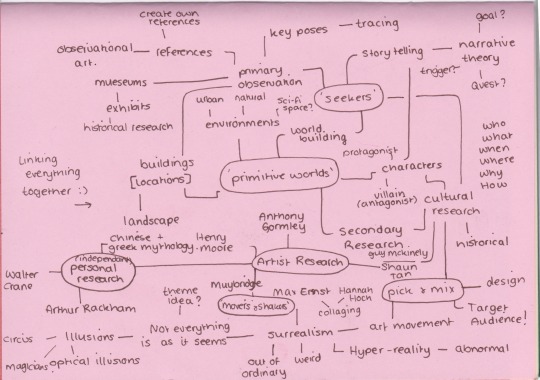
I have three separate ideas for this FMP, but this does not mean that I might pick only one. I’m still open to newer ideas. Once I have gathered together my research and inspirations, I will begin to develop it and start to link it back to previous projects.
In this blog, I will go over the brief idea of each concept and then list out how it links to previous research and projects. I will also describe how each idea came to me.
1 - Glass City
This was my first idea, inspired by the preparatory task at the beginning of the FMP. I took inspiration from a glass diamond. Upon closer inspection, I found that the shapes inside looked like the street of a city at a high perspective. This idea follows a main character trying to achieve some sort of goal in this universe. It was fun to think about if a city were made out of glass, what it would mean for the people living there, nature and the ruler. I came up with the concept of a mayor with some aspect of unstable obsessiveness with being able to see everything that’s going on in the city. No secrets. No privacy.
The pros of this idea is the aesthetics I think I can get with this. Especially when looking into how light interacts with transparent objects and surfaces. What colours can I use that will make it look dream-like enough? Another pro to this idea is the way I heavily want to link it back to surrealism. The civilians would most definitely have parts of their features and personalities disorientated and strange looking. Everything would be topsy-turvy, where fish can fly and birds swim.
Would this be an actual reality or would it be a good idea to make all the surreal aspects of this universe have a metaphorical meaning? None of it is actually real, rather from the mind of a young protagonist with a very big imagination?
I could explore surreal character design inspired by the work of Max Ernst and Lewis Carroll (Alice in Wonderland in particular.)
I could look further into light source and its relationship with transparency.
I could work towards an outcome of a highly detailed, large scale illustration that compliments this universe, along with a short comic.
I could also look back at Primitive worlds and perhaps think about trying to build a miniature scale version of this city. (An idea I would have to look into more about materials and how I could work this out.)
Projects this links back to:
‘Seekers’ - Narratives, Character Design
‘Primitive Worlds’ - Potential 3d diorama, Character Design, World building
‘Pick & Mx’ - Character design, Surrealist art movement.

I stuck with this sort of idea for a while, but due to further research I did into Alice in wonderland, and then into the 1950′s, I began to have an idea of something a little different but still in a city setting. This idea also came to me after I interpreted the word ‘Encounters’ for myself using a mind map: A significant meeting of two unique strangers. They have to be extremely different and their meeting must trigger an adventure or ‘quest’.
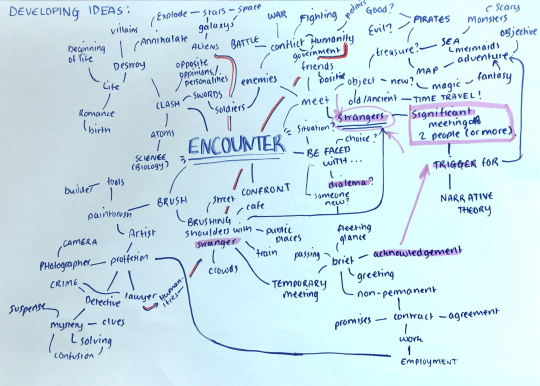
2 - Switched Bodies Idea
The main idea of this concept is quite a simple one but perhaps over-used? The main protagonist would likely be a young but talented detective who is trying to solve a mystery of (*something*) for someone. He’s very talented and one of the best, but as soon as he thinks he’s come close to solving it, he realises it’s a trap and that someone who employed him is actually trying to kill him. Despite the heavy, darker turn of events, while on the run he bumps into a young girl and they switch bodies because of (*something*). This somehow makes him lose the bad guys but now he’s in a 10 year old girl’s body. Then he has to try to solve the mystery with her help so that they can reveal the truth and switch back, thus forming an unlikely friendship.
I’m not sure what it is with me and unlikely friendships developing over a narrative (especially considering my ‘Seekers’ project theme), but I’m all for it.
The themes of this would be mostly comedic, with aesthetics from the 1950′ s detective tv shows and western comic book art. The plot would likely be very character development heavy, as both main protagonists are introduced to extremely different view-points. Their differences will be understood when they learn to live in each others shoes.
Out of the ideas I have come up with already, this is the one that I favour the most currently. But this may change depending what knew things inspire me or if another idea pops up that I like more. Some outcomes I could consider are:
A pose to pose walk cycle of the two main characters. Coloured and Shaded.
Research on western detective shows/animations. Also aesthetics of cartoons in the 1950′ s
Contextual research about the 1950′s aesthetics, influences and life style.
A comic book of about 10 pages illustrating the protagonist’s ‘Encounter.’
Projects this links back to:
‘Seekers’ - Narrative, pose to pose animation
‘Movers & Shakers’ - Muybridge cycles
‘Pick & Mix’ - Character Design, Character turn arounds


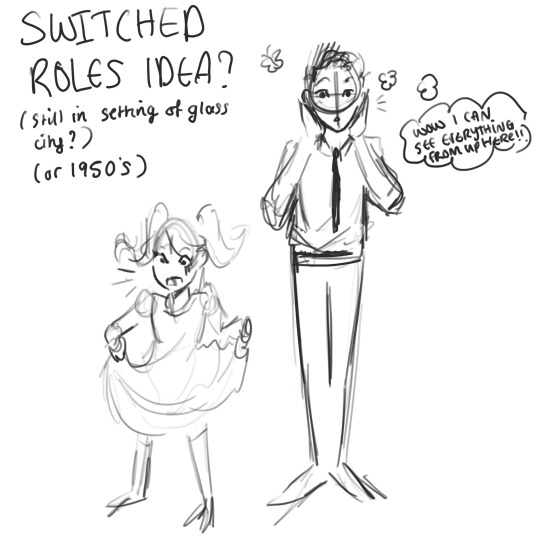
3 - Deep Sea Encounter
This idea was inspired by the Dark Room elective I had every week especially the second week of it where we looked at another form of creating photos using light sensitive materials. This process is called: Cyanotype printing.
As you can see in the blog were I write up that week’s elective, the effect of it is a deep blue background and a white outline. My favourite part of it was the way any white bits seemed to glow. It gave me an idea of a potential under water scene. The encounter would be between a mermaid and a diver. He drops his flare and in a panic to get it back, he gets himself tangled up in a net. A mermaid is drawn to the light of it and so she meets the diver, but she isn’t so keen to give it back because she thinks it’s pretty. This is the most vague idea out of the three because there are some big plot holes I would have to fix if I were to pick this. But if I were to create some illustrations based on an undersea world, I think the aesthetics would look really nice. Especially since I can still sort of keep that light source research in mind, seeing how light reacts through water.
The downfalls of this idea are that I think it’s too much like The Little Mermaid, a very well known story. Although I could link mermaids to surrealism, I think that claim would be weak as mermaids are well known fantasy creatures, frequently seen in books and other media. Surrealism is the strange and shocking, so despite that mermaids don’t resemble real life, I don’t think they are particularly mind boggling enough to truly feel like something out of the unconscious mind. However, some outcomes I could work towards with this idea are:
A rotoscoped animation
Character Turn Arounds
Research on certain types of fish and developing them into personified mer-people.
Contextual Research on mythology surrounding Mermaids such as Sirens. (Particularly Greek Mythology, but a little say from every culture would be interesting.)
Finalised illustration.
Projects this links back to:
‘Movers & Shakers’ - Rotoscoped Animation
‘Seekers’ - Narratives
‘Pick & Mix’ - Character design, Surrealist Movement

0 notes
Text
So okay hey y’know what’s a thing that bugs me about Shadow’s arc throughout the games?
The Biolizard and the Black Arms.
Because... two times, there’s the person that Shadow has the actual, justified beef with, and then a second party who is connected pretty directly to Shadow. A peer.
The Biolizard is Shadow’s prototype, which, considering Gerald, at least before the massacre, was as far from a cold uncaring researcher as possible- this is Shadow’s older sibling. And, yeah, as a prototype organisms, she has some serious health concerns- her tendency to hyperventilate definitely being one of them- but it doesn’t seem like she’s suffering.
And, yeah, she doesn’t vocalize, isn’t small and Mobian-like but there is clearly someone home. A mindless animal ruled only by instinct would not be taken as the vehicle for Gerald’s revenge. A mindless animal couldn’t operate the ARK’s systems, much less by projecting them, or use the sophisticated, complex attack pattern that the Biolizard does- comparable to Eggman’s boss robots. Hell, one of the hardest things to do fighting Biolizard is dodge. She’s a really good shot, and the one exploitable opening in her combat is where she needs to stop and hyperventilate with her life support, which, she can’t exactly do anything about.
Hell, you’d argue considering the whole repetition of “power enriched by the heart” that whatever nebulous sources we have in Sonic would state that Biolizard has a soul. She has to have a will and “heart” or how would she be able to use Chaos Control?
Biolizard is smart. And what’s the other thing we see about Biolizard? That video left behind by Gerald- repeating over and over and over again.
The video left behind by Gerald- who tampered with Shadow’s memories and otherwise twisted a quiet, sensitive, traumatized individual into his vehicle for revenge.
This is the one thing we “hear” from Biolizard who is absolutely smart enough to communicate somehow. Who, if we assume she, like Shadow, is synthesized from Arms DNA, would probably have been on some level communicating with Shadow the entire time- considering Shadow’s the one utterly unsurprised when Biolizard warps in to mess them up.
The Biolizard was manipulated and exploited by Gerald just like Shadow was. Much like Shadow, we have no reason to believe she is inherently violent or hateful. There is no good reason to carefully and lovingly deliver Shadow from Gerald’s machinations and kill Biolizard.
“But Clockie, she would’ve killed everyone with the ARK!”
So would Shadow, given he was instrumental in delivering the emeralds to Biolizard in the first place, and literally in the scene leading up to the Biolizard fight he’s calmly looking out the window waiting for the impact.
Literally- Shadow’s realization that this was wrong was a last second incident.
What did the Biolizard believe? What was her perspective on the ARK? She’s so large and heavy- unable to move through most of the facility except by teleporting- did she hide and avoid GUN? Was she captured? We have no idea. But Gerald clearly tampered with her- the presence of the video aligns directly with her appearance.
Just like Shadow, she was acting on his orders. And we don’t know how easy it is for Biolizard to communicate or understand- it might be hard for her to get a grasp on her situation just through eavesdropping on the united Hero & Dark teams.
I could write this entire post on the ambiguity of “Supporting Me” and how much it sounds like a conversation more than a soliloquy. “I know you were supporting me,” and the repetitions/variations on that- who is he talking to, or, rather, who is talking to him? A lot of the lyrical SA2 themes are very straightforwards- almost comically so at times- but Shadow’s themes for that game are... weird. Ambiguous. Distorted. I’m honestly kind of sad they dropped that for his later games, but that’s getting off topic.
Biolizard, in every way, is just like Shadow, and we watch her rip herself apart trying to fulfill Gerald’s revenge with no idea if this was ever what she really wanted. The finalhazard form looks incredibly painful. This is someone who has a body that does not lend itself well to stress-free movement and the tendency to hyperventilate when overexerting herself and she never hesitates to protect herself.
And, for all that? For all of her sharing Shadow’s tragedy? We get nothing. No sympathy. Not even a second thought except “wow wasn’t that a cool boss fight” in Sonic Generations. Shadow calls her an ugly prototype. Her downfall is treated as synonymous to Gerald’s downfall- she’s treated as a mere symptom or face of his revenge.
And this is, quite frankly, so much of how the Black Arms are handled. Shadow finds another messed up branch of his family tree in Black Doom, who is all too eager to do exactly what Gerald did- gaslight Shadow and use him for Doom’s personal vendetta. Only unlike Gerald, Doom isn’t a desperate specter from the past, he’s the patriarch of an entire species. What he’s trying to do to Shadow, he’s already done to all of the other Arms.
The Black Arms- who are, seemingly, hypersocial, mentally linked on an incredibly intimate level, and who would be, thus, incredibly vulnerable to exactly the kind of manipulations and attacks Doom lavishes on Shadow.
Once again- the only reason Shadow is our hero, the only reason he’s spared, is because of the people who reach out to him, in past and present. And this is framed as a very narrow thing- sure, most of the routes, especially the dark routes, are noncanon, but it’s still emphasized as a very real possibility that Doom is able to break Shadow entirely to his will.
But again- for the Arms? There is no sympathy. They’re in exactly the same boat as Shadow, as far as carrying out Doom’s orders against Earth, the angle of the True Ending tells us that the Pure Hero route is as noncanon as the Pure Dark route- that at bare minimum, Shadow gave Doom the Chaos Emeralds and put Earth in danger. Hell, even more than Biolizard, you can argue the Arms may have actually had no awareness or control of what they were doing- Gerald’s manipulations just convinces the person that this is what they need to do in a guise they’re least likely to refuse, but consider how incredibly off Shadow acts in the scenes where he’s heavily under Doom’s influence.
And this is infuriating to me not only because Biolizard and the Black Arms are written off, but because- a significant plot thread for Shadow going onward from his decision to turn his back on his history and try to use his power for good is that he has like two friends and is in an incredibly difficult situation to relate to people.
What I’ve seen of Archie’s plot exploring Eclipse and the Dark Arms... also, honestly does not encourage me, because Shadow’s sibling seems to be presented overwhelmingly as a corrupting force, and the heroic course of action is for Shadow to once again fight off his extended family.
Which... if Shadow’s a Black Arm, and the Arms are a hypersocial colony species... is it really any wonder Shadow’s not doing so hot, or why the familial ties of Gerald and Maria meant so, so much to him? Sure, genetic influences only do so much in the realm of the psychological but if Arms aren’t even supposed to be completely alone in their own heads, outside of the freaky subjugation that Doom gets up to- there have been studies that babies will die from insufficient contact.
I could write an entire different post on the beautiful, beautiful found family feelings I have over Team Dark’s relationship, and how wonderful Rouge and Omega are as stabilizing forces in Shadow’s life (I mean, heck, look at the fact that in some of the worse routes in ShTH they’re there for him- Rouge in particular is your lone ‘get out of jail’ card to help you away from the worst ending)...
...but that’s not to say that he’s fine, and it doesn’t matter if he’s alone.
Nobody’s going to argue they should’ve blown up Earth with ARK, or that Doom was anything but an abusive, tyrannical person who needed to get his miscellaneous appendages out of Shadow’s brain. And I’m not trying to spin this at all to suggest leaving his biological family means Shadow’s Never Going To Be Happy- that’s an awful message to send because sometimes, people really do just need to cut ties with their blood relatives.
What aggravates me is that there’s no satisfactory explanation or even acknowledgement for why Shadow is the one redeemed and not his siblings, when it seems like the only thing that separates them is once again, that people reached out to Shadow.
Which is ridiculous because our supporting cast is packed with people who care!
Rouge paints herself as only in it for personal gain in contrast to the selfless, duty-bound Knuckles, her rival- and yet even her debut game framed her repeatedly as someone who ultimately is kind, trustworthy, who says things like “Even if the world turns against you, I won’t,” and means it. Hell, in SA2, she was the one who was actively an undercover agent for the forces of good.
Eggman wants to take over the world but god dammit he has standards, he deplores senseless destruction- we see him angrily decry both Gerald and Doom, the former rather personally since Gerald was his hero.
And Sonic? It’s pretty solidly established Sonic will take under his wing and give an affectionate nickname to anything that’s around him for more than ten minutes.
This is not an arrangement of people who don’t care. There’s no actual good in-universe justification for the Biolizard and the Black Arms being met so coldly when none of the amounts of violence they enacted or attempted exceeded Shadow’s.
Also there are so many incredible ways to explore the idea that Shadow is related to a freaking space dinosaur. Literally whatever character you ascribe to the Biolizard, it’d be amazing.
#Sonic#Shadow the Hedgehog#Biolizard#Black Arms#readmore#abuse mention /#death mention /#long post /#very long post#Clockie gets heated about Sonic#in before anybody tells me SEGA doesn't think about it that much#I know and I don't care#we could've had it all
193 notes
·
View notes